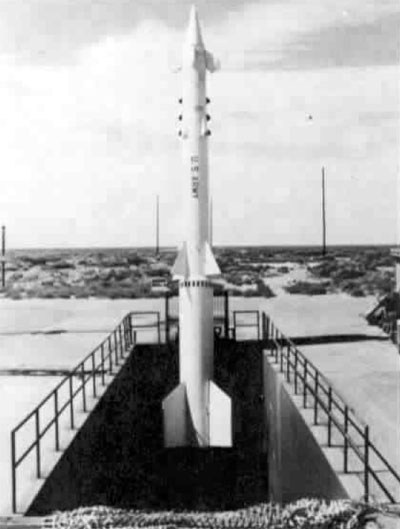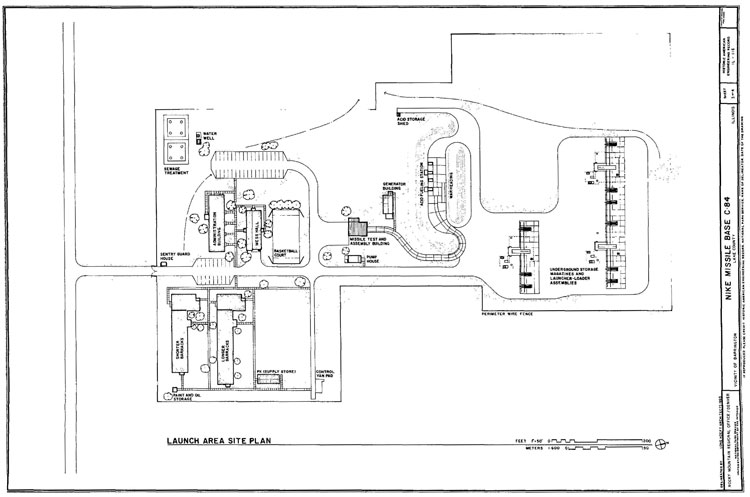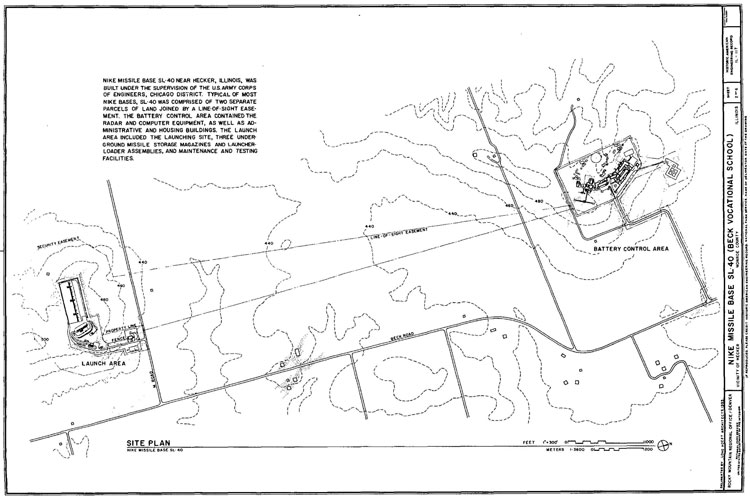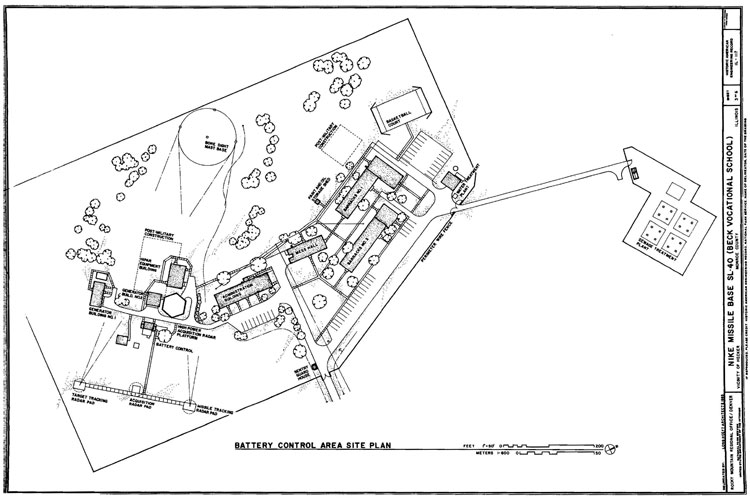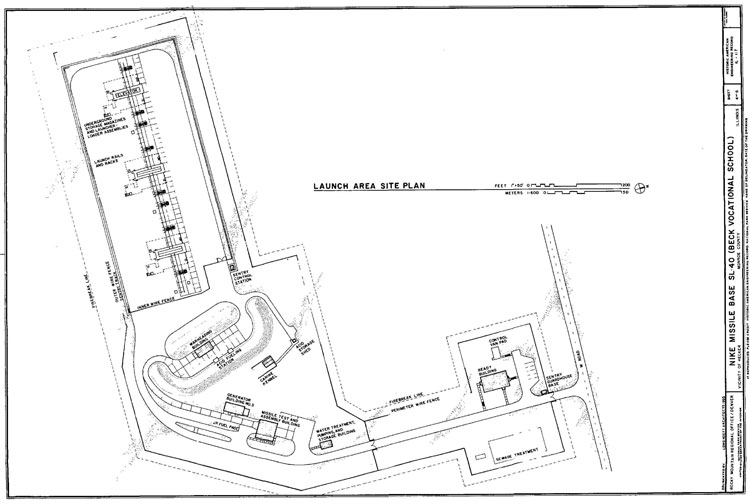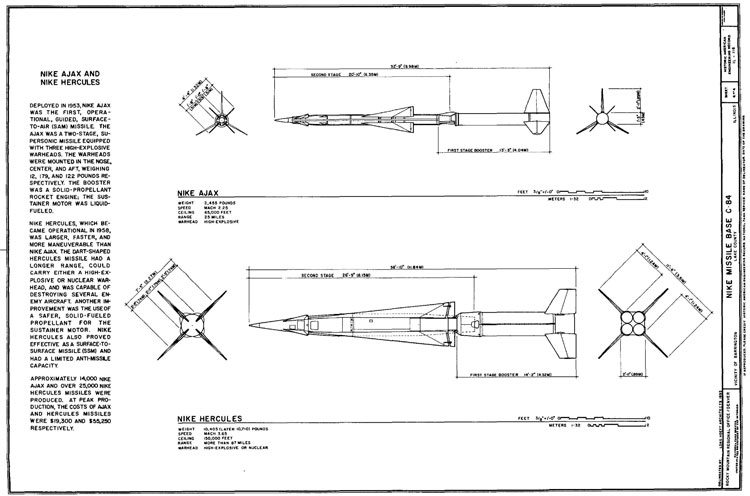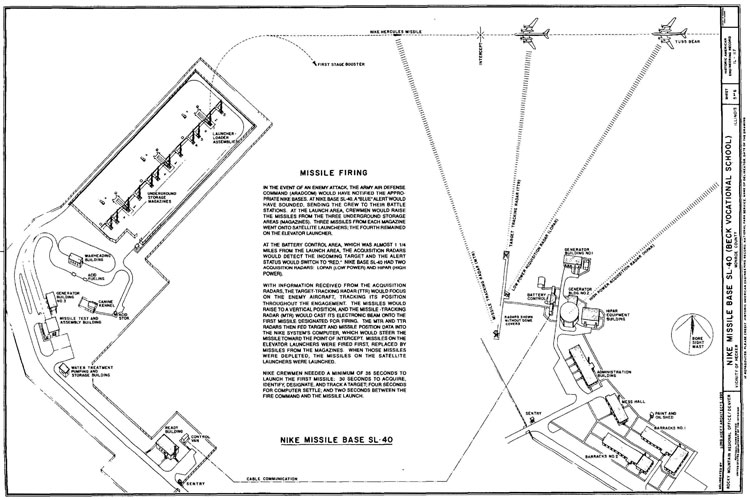Slave to the Game
Online Gaming Community
ALL WORLD WARS
LAST LINE OF DEFENSE. NIKE MISSILE SITES IN ILLINOIS
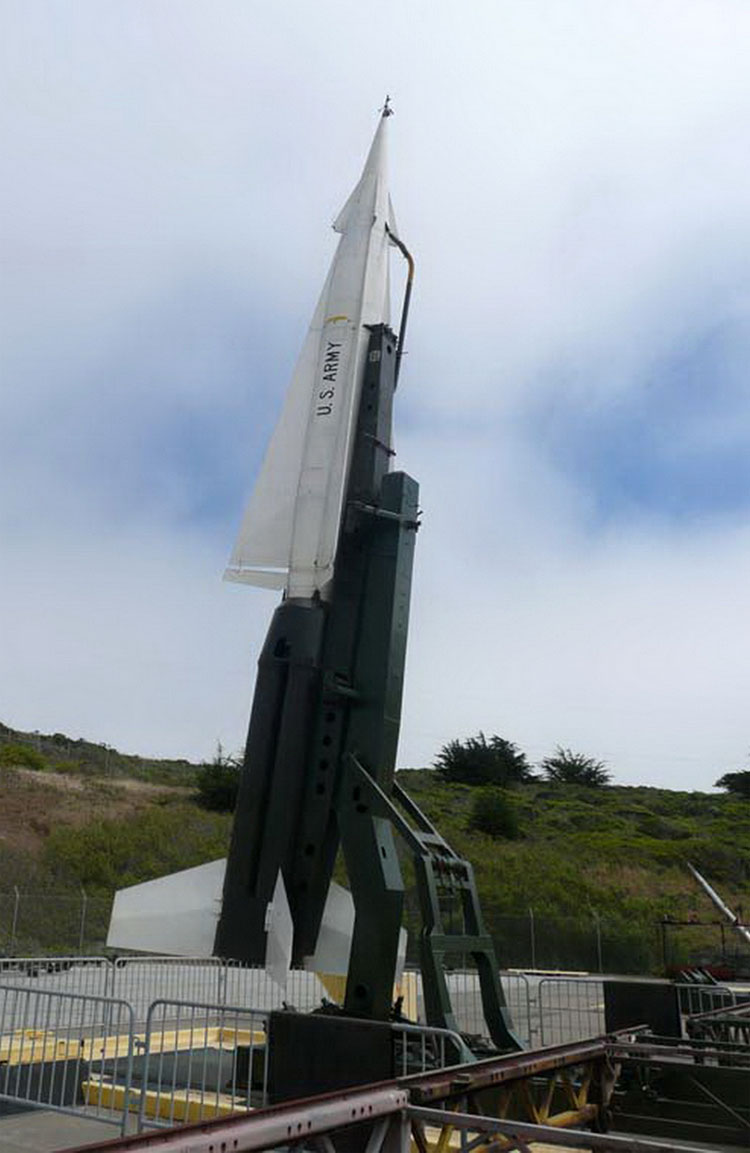
Western Digital MIM-14B Nike Hercules at Nike Missile Site SF-88L, located in the Golden Gate National Recreation Area near San Francisco, is the only Nike launch site in the country that has been restored for public visitation.
LAST LINE OF DEFENSE. NIKE MISSILE SITES IN ILLINOIS
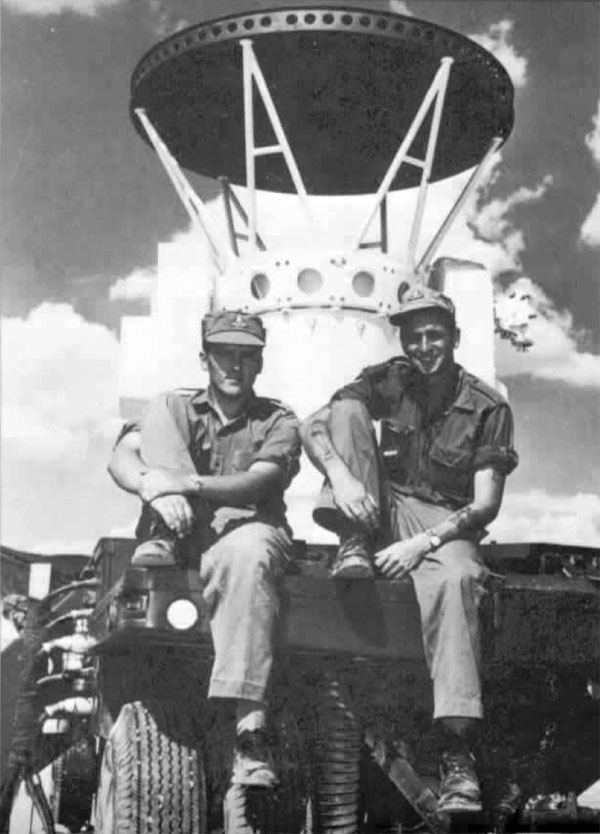
HISTORY
Christina M. Carlson and Robert Lyon
PHOTOGRAPHS
Arnold Thallheimer
DRAWINGS
Kathleen Hoeft and Chalmers G. Long. Jr.
EDITING
Christine Whitacre
DEPARTMENT OF DEFENSE
US ARMY CORPS OF ENGINEERS. CHICAGO DISTRICT
DEPARTMENT OF THE INTERIOR
NATIONAL PARK SERVICE. ROCKY MOUNTAIN SYSTEM SUPPORT OFFICE
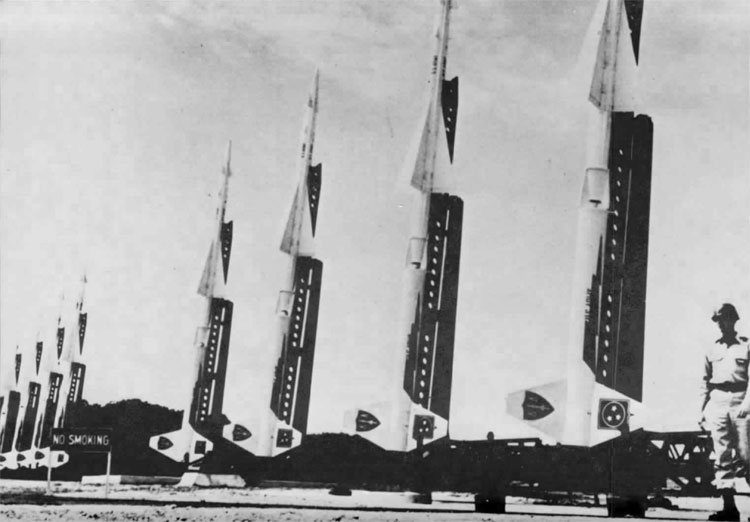
Nike Ajax missiles, REDSTONE ARCENAL.
PREFACE
In 1991, the US Army Corps of Engineers, which oversaw the construction of the nation’s Nike missile bases, asked the National Park Service, Rocky Mountain Regional office, to prepare Historic American Engineering Records (HAER) of two Nike antiaircraft missile sites in the State of Illinois. Although the missile and radar equipment had long since been removed from these bases, the Corps of Engineers – in consultation with the Illinois Historic Preservation Agency – recognized that these military installations represented a significant chapter in the history of the Cold War. Nike Missile Base C-84 near the Chicago suburb of Barrington, Illinois, was one of 23 Nile missile installations that comprised the Chicago (IL)-Gary (IN) air defense system. Nike Missile Base SL-40, near the farming community of Hecker in southern Illinois, was one of five Nike bases that formed a protective ring around the St. Louis (MO) metropolitan area.
Since the 1966 passage of the National Historic Preservation Act, government agencies have attempted to mitigate damages to historic properties caused by Federal projects. Triggered by Section 106 of the Historic Preservation Act, this mitigation often results in the preparation of HAER documentation, which provides a documentary and visual record of a historic site. In the case of the Illinois Nike sites, the Chicago District of the Corps of Engineers was preparing to surplus numerous Nike installation landholdings within the state. Since that surplus was likely to result in the demolition of the bases, the Corps of Engineers, in partial fulfillment of its Section 106 responsibilities, agreed to document the two most intact Nike installations in Illinois. That documentation was prepared through an interagency agreement with the National Park Service, Rocky Mountain Regional office.
In recent years, there has been an increased appreciation of America’s Cold War sites. Neither Nike Missile Base C-84 or SL-40 are 50 years old, the standard marker for historic recognition. But, as world leaders grapple with the implications of the end of the Cold War (1945-1989), America’s preservation community has become increasingly involved with recording and preserving the tangible evidence of that conflict within the context of national experience. The HAER recordation of the Illinois Nike sites reflects this increased emphasis on the Nation’s recent past.
In recent years, the Rocky Mountain Regional Office (since reorganized as the Rocky Mountain System Support Office) of the National Park Service has been a leader in that effort. In 1995, the Rocky Mountain Regional Office completed a Historic American Engineering Record of a Minuteman intercontinental ballistic (ICBM) missile site. The study focused on the Delta One and Delta Nine Minuteman launch facilities in South Dakota, and recommended a plan for their preservation, including the possibility of making them a National Historic Site. Other recent and/or ongoing Cold War projects include the HAER documentation of the Rocky Mountain Arsenal (Colorado), the Glenn L. Martin Company Titan Missile Test Site (Colorado), the Oscar One Minuteman Missile Site (Missouri), and a Strategic Air Command aircraft alert facility (Missouri).
The Historic American Engineering Record was established in 1969 by the National Park Service, the American Society of Civil Engineers, and the Library of Congress. Its purpose is to record the Nation's historic engineering, industrial, and transportation resources. Under the tripartite agreement, the National Park Service administers the HAER program with funds appropriated by Congress and supplemented by outside donations. By their very nature, Historic American Engineering Record projects require numerous people with diverse professional backgrounds, and several people worked on the HAER recordation of Nike Missile Bases C-84 and SL-40. Christina M. Carlson of BREGMAN & COMPANY, INC., Bethesda, Maryland, and Robert Lyon, a historian with the National Park Service, Rocky Mountain Regional Office, prepared the histories. Arnold Thallheimer of Custom Photography in Austin, Colorado, took the large-format photographs of the sites, and Kathleen Hoeft and Chalmers G. Long, Jr., of Long Hoeft Architects, Georgetown, Colorado, prepared the measured and interpretive drawings.
Funding for this publication was provided by the U.S. Army Corps of Engineers, Chicago District. Corps Archeologist Keith Ryder participated in the selection of the two Nike sites to be documented, and assisted in obtaining research materials. He also developed the scope of work for the recordation project, including this publication. Many National Park Service employees also contributed their time and effort. Michael D. Snyder, Superintendent of the Rocky Mountain System Support Office, provided overall support and direction. Historian Christine Whitacre coordinated the HAER recordation, and edited the HAER reports for publication. Lysa Wegman-French provided technical review and support, as did Architect Thomas Keohan. Ramona Ruhl edited and formatted the final HAER reports. Special thanks are offered Interpretive Specialist Richard M. Kohen for his excellent design and layout.
Gregory Kendrick, Program Leader
Cultural Resources
Stewardship and Partnership Team
Rocky Mountain System Support Office
National Park Service
INTRODUCTION
The Nike-Hercules Story, a promotional film distributed by the U.S. Army and Bell Laboratories in the 1950s, vividly illustrates the fears generated by the Cold War. In the film's opening scenes, a group of children play on the picket-fenced front lawns of what appears to be an ideal American suburb. As a young boy throws a toy airplane into the air, the camera follows the shadow of the make-believe bomber soaring above the street. Suddenly, the film's playful mood ends. An adult watching the airplane is reminded of the atomic bombing of Hiroshima, and the toy plane's silhouette becomes ominous — a terrifying portent of what might happen if this were not a child's game. As the airplane casts its "thin shadow of dread" over Elm Street, the narrator speaks to the necessity of shielding America's cities and towns from enemy attack. In the immediate post-World War II years, Americans believed that such an attack was most likely to come in the form of a high-flying Soviet aircraft armed with atomic weapons.
Designed to serve as the last line of defense for American citizens, Nike installations encircled major metropolitan centers throughout the United States. Located in military bases, farmlands, public parks, and residential areas across the Nation, antiaircraft Nike missiles were a '"backyard" reminder of the fragile state of world peace in the years following World War II. Although victorious in war, America soon perceived itself vulnerable to the same atomic devastation suffered by Hiroshima and Nagasaki, Japan, in August 1945. At war's end, the United States was the sole possessor of the atomic bomb, but that monopoly was short-lived. Equally short-lived was the Nation's wartime alliance with the Soviets, who Americans now saw as their primary Cold War adversary. In 1949, Americans learned that the Soviet Union had successfully tested an atomic bomb, several years ahead of U.S. intelligence estimates. In 1952, the United States regained its nuclear superiority with an even more powerful weapon: the H (hydrogen) bomb. But one year later, the Soviet Union exploded its own H-bomb. Fueled by charges of a weapons "gap," the Cold War arms race escalated, as did Americans' concerns for their national security.
Haunted by the memory of Pearl Harbor, horrified by the possibility of nuclear devastation, Americans feared a surprise bomber attack on the United States. Antiaircraft artillery had protected America's coasts since World War I, but few of those units were on alert in the immediate post-World War II years. Moreover, newer high-flying aircraft were now beyond the range of antiaircraft guns. The Army had begun surface-to-air missile development during World War II, but it was only after President Harry S. Truman informed the Nation that the Soviets had the atomic bomb that the military received sufficient funding to act on those plans. By 1953, the U.S. Army had begun building Nike air defense systems around 40 U.S. cities and military/industrial installations. At its peak ten years later, the Nike defense system included approximately 300 batteries in the United States.
The Nation's first operational, guided, surface-to-air missile, Nike was an important technological breakthrough in air defense. The Nike system brought together an array of antiaircraft, missile, computer, and radar elements. Nike could detect, identify as friend or foe, track, and destroy enemy aircraft. Representing the close relationship between the military and private industry, the U.S. Army contracted with Bell Laboratories, Western Electric, Douglas Aircraft, and Aerojet Engineering Corporation to develop and build the system. In an effort to develop the system quickly and cost-effectively, the earliest Nike missile system was based on existing technology to the greatest extent possible. Ajax, the first-generation Nike missile, carried a conventional warhead that could destroy a single aircraft. As the United States and the Soviet Union developed more sophisticated weaponry, defensive systems became equally advanced. The second-generation Nike missile, Hercules, had a nuclear warhead that could kill several aircraft at once. Zeus, the final member of the Nike family, was designed to target high-altitude enemy missiles.
Continental air defense during the Cold War is a complex subject. The history of Nike Missile Bases C-84 and SL-40 presented here purports only to present a portion of that story, and must be viewed within the broader context of Cold War diplomacy and military preparedness. At the same time that the U.S. Army was developing and deploying the Nike systems, the U.S. Air Force produced its own surface-to-air missile systems. The similarities of those systems, and the ensuing rivalry that developed between the Air Force and the Army over them, is part of the Nike story. In addition to the Air Force and Army, the U.S. Navy and the Canadian Air Force, as part of the North American Air Defense Command (NORAD), also shared the defense mission. Nike was part of an extensive early-warning radar, communications, and weapons network — including fighter planes, Navy picket ships and dirigibles, Texas Towers, early-warning aircraft, and long-range and short-range radars —that extended from the southern borders of the United States to the arctic tundra, from Hawaii to the Azores.
Simultaneous was the development of newer, more powerful, weapons. After the Soviets launched Sputnik in 1957, America's attention turned to the development of intercontinental ballistic missiles (ICBMs). By the time of the Cuban Missile Crisis of 1962, the threat of manned bombers paled in comparison to the steady advance of ever more powerful and plentiful ICBMs. As America's ICBM arsenal increased, its defense policies changed. Nuclear deterrence became the primary means of preventing war. America's enemies would be deterred from attack, U.S. defense planners reasoned, because an enemy strike would be followed by massive nuclear retaliation.
By the time the Berlin Wall came down in 1989, signaling the end of the Cold War, the US Army had already deactivated America's Nike bases. With the exception of four batteries in Florida and Alaska, all of the Nation's Nike batteries were phased out by 1974. For additional decades, the United States continued to supply Nike Hercules missiles to foreign countries; Japan phased out its last Nike installation in 1992. Although no longer an integral part of America's air defense, surface-toair missiles have become increasingly important on the modern battlefield. The Patriot missile, a technological descendent of Nike, played a major role during Operation Desert Storm.
Although they were located near major population centers, Nike missile bases were low-scale and relatively obscure facilities. Nike battery commanders held open houses at their bases and worked to build community relations. Still, Nike installations were often closed and abandoned before many local residents understood the full extent of what lay behind the security fencing. Today, only remnants of Nike installations remain within the United States. Nike Missile Base SF-88L within the Golden Gate National Recreation Area near San Francisco, California, has been partially restored, and is open on a limited basis for public visitation. Gateway National Recreation Area in New Jersey and New York also contains portions of a Nike base. These sites, however, are the exceptions. Most Nike sites are rapidly vanishing from the Nation's landscape.
Military installations, particularly Cold War sites, present unique challenges to historians and preservationists. Created from standardized plans, Nike bases throughout the country were virtually identical; their various components rearranged to suit the specific landscape and military needs of each site. How many of these sites should be documented, and to what level? In Illinois, the decision was made to document the two most intact Nike bases within the state. These bases reflect two different defense areas, as well as two phases of missile technology. Nike Missile Base C-84 was equipped with the Nike Ajax missile. Nike Missile Base SL-40 had the more advanced Nike Hercules. The HAER recordation of Nike Bases C-84 and SL-40 also reflects another common challenge of documenting deactivated military sites. Although the buildings, including the underground missile storage areas, were relatively unchanged, the U.S. Army had removed the missile, radar, and communications equipment several years ago. As America's former Cold War sites continue to be surplused or updated, the need to accurately document military sites must be continually balanced against the demands of national security.
Today, Nike Missile Base SL-40 near Hecker, Illinois, is the Beck Vocational Center; its buildings preserved through adaptive reuse. Until recently, Nike Missile Base C-84 near the Chicago suburb of Barrington, Illinois, served as an archival repository for Lake County; the records were stored in one of the three underground missile storage areas. The base, now surrounded by suburban development, was being offered for sale and redevelopment at the time of the HAER recordation. The HAER record of these two missile sites, presented here in edited form, adds to our understanding of the Cold War, and contributes to the vast and continually growing body of literature and graphic documentation that is the Historic American Engineering Record.
Christine Whitacre, Historian
Stewardship and Partnerships Team
Rocky Mountain System Support Office
National Park Service
A FRAGILE PEACE
At the end of World War II, Americans hoped for peace and an end to the trauma of the previous 15 years of depression and war. Victory in World War II led to a period of prosperity and growth of America, but did not result in sense of security. Within five years after the war, United States would help rebuild its recent enemy, Germany, and create an alliance to oppose its former ally, the Soviet Union. The Soviet Union and the United States soon engaged in a Cold War, each side convinced the other was plotting its domination and destruction. In the ensuing arms race, both superpowers developed new weapons systems in a seemingly endless competition. Defensive as well as offensive weapon systems became part of the race, as both the Soviets and the United States tried to gain a military advantage. The U.S. Army’s Nike missile would play an important role in America's air defense strategy.
The roots of the Cold War can be traced on the Soviet side to American intervention, 1918- 1920, in the Russian Civil War against the Bolsheviks, and subsequent non-recognition of the Soviet regime until 1933. For Americans, suspicion of the Soviets was rooted in the Bolshevik calls for world revolution, the mass purges of the 1920s and 1930s, and the Soviet- German Non-Aggression Pact of August 1939 that led to the outbreak of war and a new partition of Poland. During World War II, disputes over the timing of the invasion of France, and differing visions of the shape of postwar Europe exacerbated these tensions.
In 1941, while the Red Army reeled in retreat, Soviet leader Joseph Stalin demanded territorial concessions during Allied discussions of postwar aims. Stalin wanted to keep the territory taken from Poland and Finland in 1939 and 1940, as well as the Baltic states of Estonia, Latvia, and Lithuania. Before the Teheran Conference in November 1943, Averill Harriman, U.S. Ambassador to the Soviet Union, briefed President Franklin Roosevelt on Soviet objectives. Harriman told Roosevelt that the Soviets would insist on their 1941 frontiers and were determined to have a friendly government in Poland.[1] At the same time, domestic political pressures restrained Roosevelt from making the Soviet aims clear to the American public. Congressmen with Polish-American constituencies worried about the fate of Poland long before Teheran. In August 1943, Representative John Dingell of Michigan told Roosevelt that @we Americans are not sacrificing, fighting, and dying to make permanent and more powerful the Communistic Government of Russia and to make Joseph Stalin a dictator over the liberated countries of Europe."[2] Fearing loss of support in the 1944 elections, and also fearing that Congress might refuse to join the United Nations over this issue, Roosevelt kept the question quiet. However, he could be blunt when necessary. In the summer of 1943, the President warned Polish Ambassador Jan Ciechanowski that the United States would not fight Stalin to prevent the taking of eastern Poland or the Baltic States.[3]
Disagreements between the two sides became obvious during the Yalta Conference in February 1945. Roosevelt essentially gave Soviet leader Joseph Stalin a free hand in eastern Europe because he knew there was no way to prevent it. Roosevelt understood that the American public would not have supported a new war against the Soviets in order to save Eastern Europe. However, when the reality of Soviet policies became obvious, the reactions of the American public and Congress against the Soviets were predictable.[4] On February 9, 1946, Stalin gave a rare public address in which he suggested that future wars were inevitable until the ultimate triumph of communism. The West reacted with dismay. Time magazine characterized Stalin's remarks as "The most warlike pronouncement uttered by any top- rank statesman since V-J Day." Supreme Court Justice William O. Douglas described the speech as "the Declaration of World War III."[5]
Also in February 1946, the Canadian government arrested 22 people for espionage on behalf of the Soviet Union. Searching for a rationale to explain Soviet behavior, the administration of President Harry S Truman queried Moscow's U.S. Embassy staff. George F. Kennan, minister-counselor at the embassy and a 20-year veteran of the Foreign Service, replied with the "long telegram," an 8,000-word explanation of the sources of Soviet conduct. Kennan argued that Soviet hostility to the West would last as long as its regime was based not so much on ideology as the need to justify dictatorial rule. Kennan noted that the tsars had also claimed dangers from abroad as justification for harsh methods at home. The implication was clear: Soviet behavior was based on the Soviet system's needs, not on Western actions. Hence, negotiation would have little effect towards resolving problems. Defining a policy that later became know as "containment," Kennan suggested that the United States strengthen the West, resist Soviet expansion, and wait for internal changes in the Soviet Union. Shortly after Kerman's telegram, former British Prime Minister Winston Churchill visited the United States. In a speech delivered at Westminster College in Fulton, Missouri, on March 5,1946, Churchill lamented that "from Stettin on the Baltic to Trieste on the Adriatic an Iron Curtain has fallen across Europe."[6]
In February 1947, the British informed President Truman they were giving up part of their sphere of influence in the eastern Mediterranean, specifically Greece and Turkey. Greece was in the midst of a civil war between the royalist government and communist guerrillas, and Turkey was under continuing pressure from the Soviet Union to revise the Montreaux Convention — which limited Soviet access to the Dardanelles Straits and the Mediterranean. Together, these countries needed over $400,000,000 in immediate aid, which the British could not afford. In requesting funding from Congress, President Truman characterized the war in Greece as a Soviet attempt to establish control in the Middle East. In addition, Truman stressed, "I believe that it must be the policy of the United States to support free peoples who are resisting attempted subjugation by armed minorities or by outside pressures.[7] Congress approved the $400,000,000 for Greece and Turkey. This policy — soon known as the Truman Doctrine — committed US assistance to any country struggling against communism. Containment had officially replaced the wartime alliance with the Soviet Union.
The Berlin Crisis of 1948-1949 further escalated Cold War tensions. After World War II, Germany had been partitioned into four Allied occupation zones: American, Soviet, British, and French. The weak and dependent Germans were unable to support themselves. This situation suited the Soviets, who wanted to keep Germany from ever again becoming a threat. The Western Allies wanted a rejuvenated Germany able to contribute to the European economy, and proposed currency reform among the occupation zones to revive commerce and regularize financial matters. When the Soviets refused, the Western Allies went ahead with the reform within their own zones. This move sealed the division of Germany into East and West. On June 24, 1948, the Soviets isolated Berlin, which was 90 miles inside the Soviet zone, from all ground traffic.
While the United Nations debated the crisis, President Truman used aerial transport to bring fuel and food to the desperate Berliners in "Operation Vittles." Thousands of World War II pilots were called back into service to deliver 4,500 tons of supplies per day, making more than 250,000 flights.[8] The blockade and airlift ended 11 months later when the Soviet Union gave up, in May 1949.[9] However, the damage was done. The Berlin Blockade, together with the 1948 communist coup in Czechoslovakia, convinced many Americans that Stalin would seize every opportunity to expand Soviet control.
In 1949, at the urging of the United States, the North Atlantic Treaty Organization (NATO) was formed. This new alliance included the United States, the United Kingdom, Canada, Iceland, Norway, France, Italy, Portugal, the Netherlands, Denmark, Belgium, and Luxembourg.[10] Each signatory pledged to regard an attack on any of them as an attack on all of them.[11] By banding together, the West could begin to match the numerically superior Red Army. Indeed, this policy allowed the United States to "get tough with Russia" without building an enormous military structure. By joining NATO, America committed itself to containing the Soviet Union within the territories it occupied in 1949.[12]
While most Americans shared a common concern over the spread of communism, a more immediate threat was demonstrated by the Soviet Union on September 2, 1949. On that day the Soviet Union exploded an atomic bomb — abruptly ending America's monopoly on nuclear weapons. The explosion shocked Americans, who had perceived the Russians as technologically behind the United States. When the Soviet Union exploded an even more powerful hydrogen bomb in August 1953, only ten months after America's first H-bomb test, the sense of fear and urgency increased in the United States.
American fears intensified when the Soviets unveiled their first long-range bomber, the M-4 Bison, during their 1954 May Day parade. The following year, an American Embassy air attaché visited Tushino Airport and observed twice as many Bisons as American military intelligence had estimated. Soviet officials had actually deceived the American observer. The ten Bisons that had flown overhead had made a wide circle and then had been joined by an additional eight aircraft, which made another pass over the viewing platform. The hoax succeeded in creating the impression of a larger Soviet bomber force than actually existed. When the Soviets introduced a second long- range bomber, the Tu-20 Bear, bilk of a bomber "gap" began. Succumbing to the deception. Air Force intelligence estimated that the Russians would have 600 to 700 strategic bombers operational by 1959.[13]
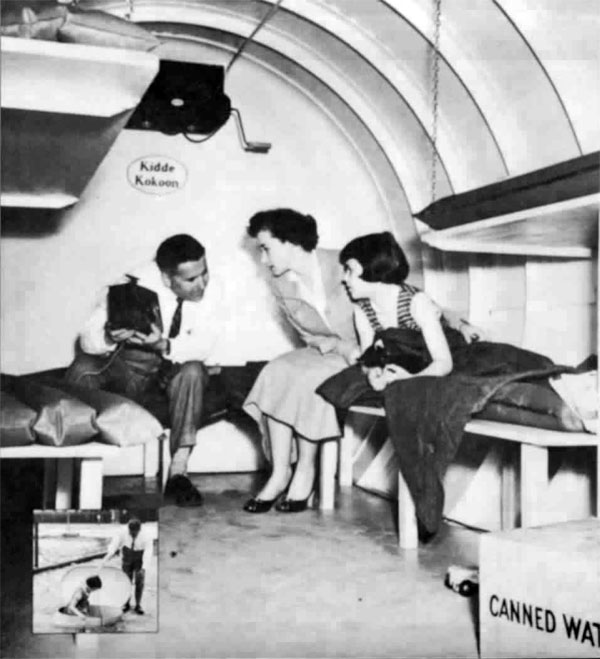
As the Cold War's arms race escalated, the united States encouraged citizens to build fallout shelters, and created civil defense systems to cope with enemy attack. UPI.
Despite the hoax, the United States was forced to acknowledge that the Soviet Union had developed a long range bomber capable of delivering a nuclear weapon from Siberian air fields to the continental United States. The frightening prospect of a long-range Soviet bomber dropping a nuclear warhead on an unsuspecting American city resurrected a "Pearl Harbor atmosphere" in the United States. As nuclear stockpiles increased, the United States encouraged citizens to build fallout shelters and created civil defense systems designed to cope with an enemy attack.[14] In 1956, Congress added $928 million to the Air Force budget for the purchase of B-52 aircraft. At the same time, the U.S. Army, the armed service responsible for protecting American ground forces, also was anticipating the threat of an enemy strike. As early as 1953, the Army began deploying the first Nike antiaircraft batteries around American cities.
NIKE DEPLOYMENT AND U.S. AIR DEFENSE
America’s first military organization devoted entirely to air defense was the Air Defense Command (ADC), which began on February 26, 1940, at Mitchel Field, New York. The Air Defense Command was created following a recommendation by Major General Henry "Hap" Arnold, who had pointed out the weaknesses in America’s air defense system. The Air Defense Command was formed to "conduct experiments in the northeastern states to determine how fighter planes, antiaircraft artillery, and an air warming system could be integrated into a single air defense network."[15]
New to the problem of air defense, the Air Defense Command looked to the British example. In August and September 1940, during the Battle of Britain, the British had shown that a well-dispersed air force was a difficult bombing target, and demonstrated the value of an early warning system based on radar.[16] The United States undertook several large- scale exercises that attempted to unify all air defense elements. On the basis of this experimentation, the Air Defense Command recommended that the United States follow Britain's practice of placing air defense responsibility under pursuit aviation commanders.[17]
On March 7,1941, the War Department assigned the mission of air defense to the Army Air Corps. The Army Air Corps created four numbered air forces, each with an interceptor command assigned the mission of air defense. The numbered air forces were responsible for organizing and planning, while the interceptor commands carried out air defense operations. These operations included control of antiaircraft artillery (AAA) units trained and administered by the Coast Artillery Corps, which was charged with the mission of developing weapons and techniques.[18] However, lack of funds and commitment prevented these units from becoming part of a unified, fully prepared air defense system.

Nike installations ringed America's major metropolitan areas. The chief objective of the Nike system was to provide a defense against enemy aircraft at ranges and altitudes beyond those of conventional artillery. A Nike installation's low- scale buildings and underground missile storage areas were relatively obscure in their surrounding suburban and rural farmland environments. REDSTONE ARSENAL.
Prior to World War II, the possibility of America being struck by an enemy air attack was remote. Protected on both sides by oceans — and with the limited range of aircraft — America seemed insulated from European or Asian air attack. The Japanese attack on Pearl Harbor on December 7, 1941, dramatically illustrated the weaknesses of American air defense. Following Pearl Harbor, the nation was forced to implement an air defense system that was still in its infancy; only eight months had passed since the Air Corps had received overall responsibility. Early in 1942, the Army reorganized into three principal elements: the Army Ground Forces, the Army Air Forces, and the Army Service Forces. Each received separate but related duties.[19]
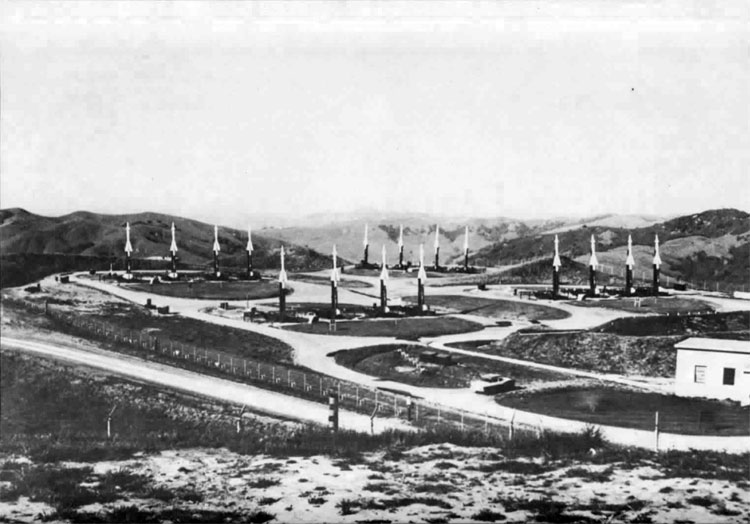
Nike missile bases were built from standardized designs, but variations existed. The Nike Ajax base pictured here included four launch pads, shown with missiles in firing position, Nike bases C-84 and SL-40 ' each had only three launch pad areas. REDSTONE ARSENAL
As the United States entered World War II, there was little doubt concerning the importance of antiaircraft artillery. On March 9, 1942, the War Department activated the Antiaircraft Command as part of the Army Ground Forces. With Major General Joseph A. Green serving as its first commanding general, the Antiaircraft Command's primary mission was "to instruct and train officers and enlisted men for duty with antiaircraft artillery and barrage balloon units, and to activate, organize, equip and efficiently train such units for combat service."[20] The War Department established the Antiaircraft Artillery School at Camp Davis, North Carolina. Two years later, the school moved to Fort Bliss, Texas, where the clear weather and solitude accommodated excellent year-round training and testing. Between March 9,1942, and September 2,1945, the command trained 613 antiaircraft artillery combat units for deployment overseas and in the continental United States.
The Army Service Forces, through the Chief of Ordnance and Chief Signal Officer, also played a significant role in air defense through procurement, delivery, and equipment maintenance.[21] At the same time, the Army Air Forces maintained operational control of air defense through its four numbered air forces. This complex organizational structure caused difficulties. In 1942, the Army Ground Forces and the Army Air Forces had "sharp disagreements" concerning the circumstances under which an antiaircraft artillery unit could begin firing.[22] Each side argued that it should have the command to control the antiaircraft artillery units. The issue, however, remained unresolved.
As Nike research began in 1945, the rivalry over the control of America's air defense systems escalated. The Army Ordnance Corps was responsible for Nike development, but the Army Air Forces had overall responsibility for air defense. In 1946, the War Department issued several directives that led to different interpretations by the Army Air Forces and Army Ground Forces. Finally, in September 1946, the War Department resolved the controversy by declaring that Army Air Forces would control antiaircraft artillery units with air defense missions. The War Department also determined that the Air Defense Command would provide Army Ground Forces with some degree of influence by integrating antiaircraft artillery officers into its staff. Army Ground Forces also remained responsible for providing the technical training of antiaircraft units.
The disagreements over air defense coincided with the military's "turf wars" over missile systems. After World War II, America's defense planners and aeronautical firms accelerated their missile development programs. Between March and April 1946, the Army Air Forces Commander "Hap" Arnold authorized 28 missile projects. At the same time, the Army Ground Forces and the Navy proceeded with their own missile programs. In an effort to develop an overall structure for America's burgeoning missile program, the military divided these missiles into four basic categories: air- to-air, air-to-surface, surface-to-air, and surface-to-surface. However, it proved to be much more difficult to divide up the responsibilities for those weapons.[23]
In July 1947, the National Security Act created three separate military departments: Navy, Army, and Air Force. However, the act failed to adequately define the roles and missions of the departments. It also failed to stem the interservice rivalry. Separate from the National Security Act, the Army and the Air Force formulated over 200 agreements regarding air defense. These agreements, which became known as the Eisenhower-Spaatz Agreements, resulted in the Air Force having operational control of air defense, while the Army staffed the air defense units. Also under these agreements, both the Air Force and the Army controlled surface-to-air missiles, but under different circumstances. The Air Force was in charge of surface-to-surface ''pilotless aircraft" and strategic missiles. The Army controlled tactical missiles, defined as those missiles that supported and protected ground operations. The Air Force also was responsible for surface-to-air missiles for area defense, while the Army controlled surface-to-air missiles that protected field forces from air attack.[24]
President Harry S Truman, in an effort to strengthen America's air defense, directed the Air Force to reorganize in October 1948. The Continental Air Command was formed on December 1,1948, headed by Lieutenant General George E. Stratemeyer. The Air Defense Command fell under the Continental Air Command jurisdiction, resulting in the Air Force retaining overall responsibility for air defense. At the same time, the Army continued to provide antiaircraft artillery units and personnel to support the air defense function. Not surprisingly, disagreements continued between the Army and Air Force over air defense responsibilities.
In 1949, in an effort to clarify roles and responsibilities, the Army recommended that it be responsible for all surface-launched missiles, while the Navy controlled ship-launched missiles and the Air Force controlled air-launched missiles. In 1950, the Joint Chiefs of Staff (JCS) agreed to a variation of the Army's recommendation. The JCS assigned to the Air Force and Navy the responsibility for surface-to-air missiles that supplemented interceptor aircraft. The Army and Navy were responsible for short- range surface-to-surface missiles that replaced field artillery, as well as surface-to-air missiles that extended the range of antiaircraft artillery.[25]
Another concession the Army won was to establish an antiaircraft artillery chain of command, which became the Army Antiaircraft Command (ARAACOM). The Army activated ARAACOM in 1950, immediately following the beginning of the Korean War. The Army Antiaircraft Command was based at Ent Air Force Base at Colorado Springs, Colorado. At first, ARAACOM only had oversight for planning and training. On April 10, 1951, the Army Aniaircraft Command assumed actual command of Army defense units. By July 1951, the Army Antiaircraft Command headquarters commanded a total of 38 antiaircraft artillery battalions. [26]
The Army, Navy, and Air Force were still arguing over roles and responsibilities in 1953, by which time Nike missiles were in production. As historian Jacob Neufeld notes, 'The Army continued to claim that all missiles launched from the ground belonged in its province, as they were merely extensions of artillery. The Navy, intent on maintaining its roles and missions pursued a large number of missile projects in various areas. For its part, the Air Force firmly believed that the Army and Navy were bent on capturing Air Force roles and missions. Everywhere, it seemed, there was conspiracy.[27]
In January 1956, Secretary of Defense assigned ARAACOM exclusive responsibility for surface-to-air missiles used in point defense, including Nike missiles, which had been deployed since 1953. On March 21, 1957, the Army Antiaircraft Command was re-designated as the Army Air Defense Command (ARADCOM) — the term "antiaircraft" was now obsolete as air defense targeted both aircraft and missiles. Army Air Defense Command units defended major industrial and population centers of the United States, as well as selected Strategic Air Command bases. Army Air Defense Command Posts were established at battalion, group, or brigade level.[28]
The assignment of research and development for guided missiles — whether for area or point defense — to more than one branch of the military created not only rivalry but a duplication of effort. However, the military rationalized the duplication as a means of maximizing America's ability to have the flexibility to adjust a weapons system design to changing technological innovations and political circumstances.[29] That this duplication continued can be understood in the context of the Cold War fears of the early 1950s. Through rigged elections and coups Communists had gained control in several eastern European countries. In addition, the Korean War began and finished with no clear victory. Ernest Yanarella, in The Missile Defense Controversy — Strategy, Technology; and Politics, 1955-1972, noted that: "The fears of war breaking out at any moment, the perception of a hostile and potentially aggressive enemy capable of inducing heavy loss upon North America, and the belief in the vast potency of a military technology capable of rendering obsolete whole weapons systems — all these attitudes promoted duplication [of weapon systems] as a lesser evil to the possibility of unpreparedness."[30]
As a result, the Army and the Air Force developed separate air defense missile programs. While the Army worked with Bell Laboratories on the development of Nike, the Air Force conducted simultaneous missile development with various contractors, including a series of studies that eventually led to the development of the BOMARC missile system. In February 1946, the Air Force awarded Boeing, together with the University of Michigan, the design contract for BOMARC. (The name "BOMARC" was derived from Boeing Airplane Co. and the Michigan Aeronautical Research Center.) BOMARC was an active-homing, surface-to-air missile, which could carry either conventional or nuclear warheads.
In 1958, illustrative of the competition that developed between the Army's and Air Force's missile systems, Air Force officials called for a plan to replace the Nike bases surrounding Chicago with BOMARC bases. As the Chicago Sun Times reported:
The basis of the Air Force plan is a charge that the atom-tipped Nike- Hercules, already stationed at one site in Chicago, cannot cope with Russia's fast new jet bombers. Army officials rebutted this contention with the "hard fact, that the Hercules is already operational and easily adaptable to existing bases; while the BOMARC is distinctly a weapon of the future.[[31]
Charging the Air Force with "planning in World War II terms," the Army predicted that by the time BOMARC was fully combat-ready, Soviet bombers would no longer be the major threat to American security. The Army claimed that by 1960 "the main Russian threat will be the ICBM and its answer is the Army's Nike- Zeus," which was the last of the three types of Nike missile.[32] In 1959, the Department of Defense conducted a mock attack on Chicago to evaluate the effectiveness of Nike Hercules. Strategic Air Command bombers carried out the simulated attack. When Nike Hercules proved to be only eight percent effective against these bombers, Air Force officials used this event as an opportunity to push the BOMARC missile.[33] Ultimately, however, the Department of Defense utilized both missile systems for America's air defense — although there were far more Nike than BOMARC bases.
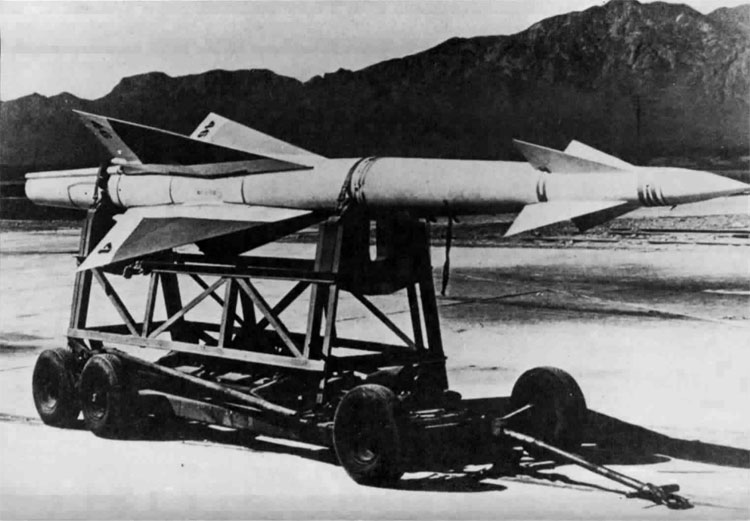
Nike Ajax was the first operational, guided, surface-to-air missile system. The missile had a 12-inch diameter and was 21 feet long (34 feet with the booster attached). The missile weighed slightly over 2,455 pounds, and carried three high-explosive warheads. REDSTONE ARSENAL.
DEVELOPMENT OF THE NIKE MISSLE SYSTEM
The first-generation Nike missile, the Ajax, was designed to intercept and destroy Soviet bombers. In the event that the Cold War turned hot, Nike missiles could provide the last line of defense for the Nation's population and industrial centers. Although the U.S. Army did not build the first Nike missile batteries until 1953, research and development of the defensive antiaircraft weapon systems began during World War II.
As the United States entered World War II, its antiaircraft arsenal included .50 caliber machine guns, 37mm guns, 40mm "Bofors" guns, fixed and mobile 3" guns, and 90mm guns. The 90mm gun was the major heavy antiaircraft weapon used by the United States during the war years. In 1938, the United States initiated development of an integrated antiaircraft defense system. That investment resulted in the development of the 90mm gun, standardized in February 1940. Using the M-9 director radar system, the 90mm gun could hit aircraft flying at 30,000 feet, and the combination of the 90mm gun and M-9 radar proved successful in World War II against the German V-l rockets. The War Department also developed a 120mm antiaircraft gun, but its large size limited mobility.
By the close of the war, advances in air warfare made it plain that even the latest antiaircraft weapons were not capable of countering future air threats. Guided missiles capable of striking high-flying aircraft were necessary. The B-29 atomic bombing mission of Hiroshima and Nagasaki in August 1945 vividly demonstrated the destructive power of high-altitude heavy aircraft. As World War II drew to a close, America's military planners began planning for air defense systems that could counter these new offensive weapons. In response to potential threats from the air, the Army began developing two separate, but related, pieces of equipment: the M-33 integrated fire control system and what would become the Nike missile.
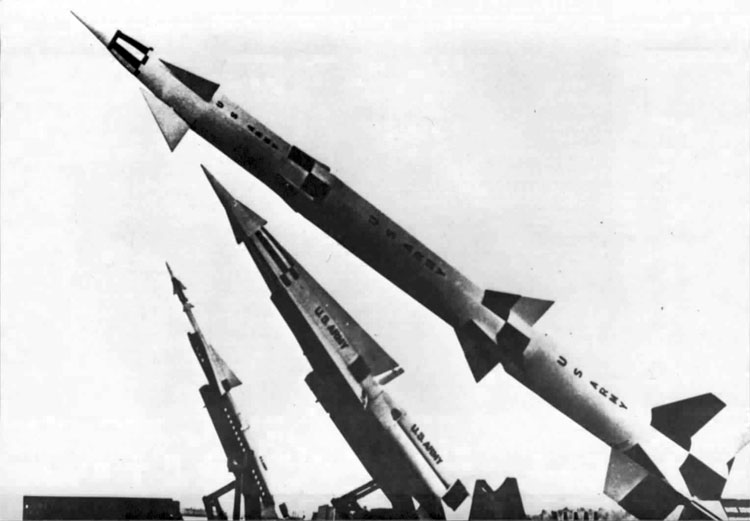
The three generations of Ajax missile: Ajax, Hercules, and Zeus, AIR DEFENSE ARTILLERY MUSEUM PHOTO.
In 1944, the U.S. Army contracted with Bell Telephone Laboratories to develop a fully integrated radar/computer antiaircraft fire control system. The result was the M-33 system. Earlier systems, such as the M-9, while successful, were a collection of individual equipment elements from various sources that were organized into working units by the military. The M-33 system, however, offered a complete radar/computer system.[34] This system, which would later operate with the Nike Ajax missile, provided the basis for a significantly improved fire control system.
On August 17, 1944, Army Lieutenant Jacob W. Schaefer submitted a memorandum proposing a new antiaircraft weapon system. The heart of this proposed system was a rocket guided from the ground that would work in conjunction with two radars linked to a computer. One radar would track incoming enemy aircraft, transmitting current location points to the computer. The computer would then calculate future target positions and be able to relay to the missile, through the other radar, any course corrections needed to intercept the enemy aircraft. The Army sent copies of Lieutenant Schaefer's technical proposal to Radio Corporation of America (RCA) and Bell Telephone Laboratories (BTL) for their consideration.[35]
In May 1945, Bell Laboratories presented a verbal report to the Army on "Project Nike" (named after the winged goddess of victory in Greek mythology). A written report, "A Study of an Antiaircraft Guided Missile System," was released the following July. The report, which was the work of a group of Bell Laboratories' scientists and engineers that included W.A. McNair, H.W. Bode, G.N. Thayer, J.W. Tukey, and B.D. Holbrook, stressed swift deployment of a weapon system that could combat high-speed, high-altitude bombers. The engineers recommended a weapon that was derived, to every extent possible, from existing technology. In order to save time and money, the engineers also recommended that the missile be as simple as possible. Bell Laboratories' engineers also urged that the more expensive and complex equipment, such as the radar system, remain on the ground where it could be re-used and have the benefit of routine maintenance.[36]
The Bell Laboratories' report recommended that Project Nike be comprised of a supersonic rocket missile vertically launched under the thrust of a solid-fuel booster, which would drop on completion of its function. The launched missile would be propelled by a liquid-fuel motor, and guided to a predicted "intercept point." The commands for missile detonation would be controlled from the ground — and transmitted by radio signals from a ground-based computer and radar system that would track both the target and the missile in flight.[37]
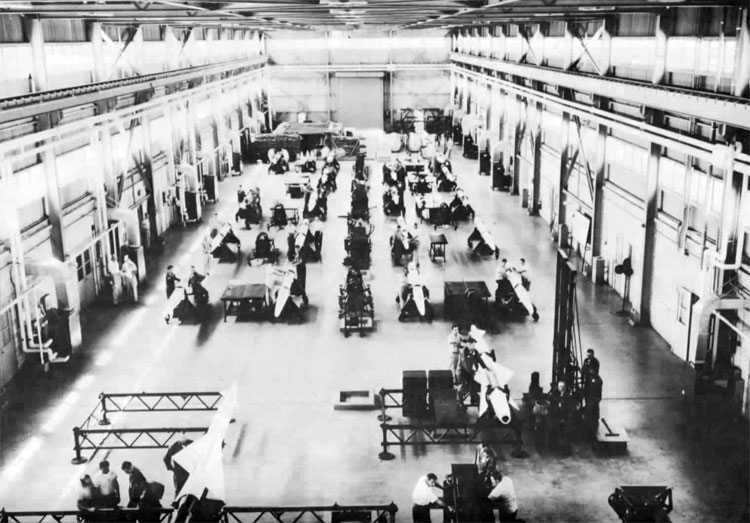
Douglas Aircraft manufactured the Nike Ajax airframes and assembled the missiles at their plant in Santa Monica, California, and at the Army Ordnance Missile Plant in Charlotte, North Carolina. REDSTONE ARSENAL.

Bell Laboratories, through its subsidiary Western Electric Company, designed the Nike systems radar and communication equipment In order to save time and money, the engineers recommended a system that was as simple as possible and based on existing technology, SMITHSONIAN.
A few months later, the Antiaircraft Artillery Board published a report that listed more specific, desired characteristics of the proposed Nike missile. The board wanted a missile that had: 1) the ability to operate effectively in high altitudes up to 60,000 feet and at ranges of 50,000 yards; 2) the ability to destroy large bombardment-type aircraft when detonated within 60 feet of the airplane; 3) a self-destruction feature; 4) the highest degree of security against interference or enemy electronic countermeasures; 5) ability to be transported by motor vehicle; and 6) an assembly period of no more than 3 hours. [38]
In June 1945, the Rocket Branch of the Army Corps (co-sponsored by a division of the Army and Air Force) assumed full responsibility for Project Nike, and named Western Electric and Bell Laboratories as the prime contractors for development of the radar system. As designed by Bell Laboratories and Western Electric, the missile command and control radar system incorporated characteristics of the M-33 antiaircraft fire control system, saving both time and money on research and development, production, logistics, and personal training.[39] The Army selected Douglas Company (later the McDonnell Douglas Astronautics Corporation) as the major contractor for the design of the missile, booster, and launcher. In turn, Douglas Aircraft contracted with the Aerojet Engineering Corporation to design the liquid-fuel rocket and solid-fuel booster rockets. Following the start of the Korean War in 1950, the Department Defense asked the contractors to produce a working version of the Nike system as soon as possible. This first missile was the Nike Ajax.
Nike Ajax
The Nike Ajax was the first in the Army's family of guided missiles, and the world's first operational, guided, surface-to-air missile system.[40] (The name "Ajax" derived from Greek mythology, where there were two Ajax characters — both swift, skillful, and strong.) The first Nike Ajax site was activated in December 1953, at Fort George G. Meade, Maryland. The 36th Antiaircraft Artillery Missile Battalion tactically deployed at this site on March 20, 1954, as part of the Washington-Baltimore Defense Area.[41] The Nike Ajax was a two-stage, supersonic missile. The missile was extremely slender, only 12 inches in diameter. Twenty-one feet long and 34 feet high with the booster attached, the missile weighed slightly over 2,455 pounds.[42] Nike Ajax carried three high-explosive warheads, weighing 12, 179, and 122 pounds, each wrapped in 1/4-inch, optimum cubic fragments. The warheads were mounted in the nose, center, and aft sections. Two arming mechanisms and five detonating cords activated the warheads, following burst orders issued from the ground.[43]
The Nike Ajax missile had a two-stage propulsion. The first-stage, solid-propellant booster produced a 59,000-pound thrust for 2 1/2 seconds, then separated and fell away as the second stage fired. A liquid-fueled sustainer motor powered the second stage. It burned jet fuel, JP-4, with red fuming nitric acid as the oxidizer. As JP-4 and red fuming nitric acid are not self-igniting, a small quantity of aniline/ furfuryl alcohol (and later dimethyl hydrazine) provided the catalyst for combustion.[44] In flight, the sustainer motor burned for 70 seconds and consumed 135 kilograms of JP-4.[45] Nike Ajax had a burnout speed of Mach 2.3, a range of 25-30 miles, and a ceiling of 65,000 feet. (Mach 1 is the speed of sound; Mach 2.3 is 2.3 times as fast as the speed of sound, or 1,679 mph.)
The Nike Ajax had three sets of cross-shaped fins, in addition to those on the booster. The forward set of fins was for steerage, the middle set was mounted with sensing equipment, while the rear set provided stability. Douglas Aircraft manufactured the Nike airframes and assembled the missiles at its plant in Santa Monica and, later, at the Army Ordnance Missile Plant in Charlotte, North Carolina. In total, Western Electric and Douglas Aircraft produced 358 ground batteries and nearly 14,000 Nike Ajax missiles for the Army during the duration of the missile's deployment.[46] In addition to Western Electric, Bell Laboratories, and Douglas Aircraft, the U.S. Army subcontracted with hundreds of other companies to supply parts for the Nike Ajax weapon system. These contracts valued approximately $1.16 billion. Research, development, and design engineering came to approximately $179.2 million; industrial services and supplies cost about $947.6 million; and the remaining $39.1 million was invested in production facilities.[47]
The last operational Ajax site in the United States ceased operations in May 1964, and a Nike-Ajax missile was offered to the Smithsonian the following November.[48] However, beginning in 1967, Nike Ajax installations were deployed in countries that shared common defense interests with the United States, such as Belgium, Denmark, France, West Germany, Greece, Italy, Japan, the Netherlands, Norway, Taiwan, and Turkey. The Army also continued to fire Ajax missiles as part of training exercises at MacGregor Range near Fort Bliss, Texas.

Nike Missile testing at White Sands Proving Grounds, New Mexico. SMITHSONIAN,
Nike Hercules
The Army began developing the next generation of Nike missile — Hercules — in 1953, the same year that Nike Ajax became operational. The Army named the missile for one of the most celebrated heroes of classical mythology, a figure renowned for strength and endurance. The new guided missile would need these characteristics in order to destroy the newer, more sophisticated generations of military aircraft. Aircraft capabilities had increased in range and altitude, demanding an improved air defense system. In addition, nuclear payloads were a greater threat. Designed to carry either nuclear and/or high-explosive warheads, the Nike Hercules missile could attack supersonic aircraft operating at altitudes in excess of 150,000 feet and at a range of more than 87 miles.[49]
Nike Hercules represented several notable improvements over the first generation Ajax. The solid-fuel booster for the Nike Hercules was a cluster of four Nike Ajax missile booster units. Another improvement was a solid-fueled propellant that replaced liquid-fueled propellant for the sustainer motor. At launch, the Nike Hercules weighed 10,405 pounds; later versions weighed 10,710 pounds. Burn-out speed was typically Mach 3.5 in early production; that speed was later increased to Mach 3.65.[50] Also improved was the acquisition radar for the Nike Hercules system, which ultimately had a range of 100 miles. The missile and target-tracking radars also had increased ranges.[51]
In 1958, the Army began replacing Nike Ajax missiles with Nike Hercules. An "Improved Nike Hercules" system became operational in 1961. The Improved Hercules could combat yet more sophisticated offensive weapons, including aircraft bombers that reached speeds of Mach 2, as well as air-supported missiles and rockets operating at velocities of Mach 3. The High Power Acquisition Radar (HIPAR) built by General Electric was also an important component of the Improved Hercules system.[52] While the range of standard Hercules radars was 125 miles, HIPAR extended the acquisition range to 175 nautical miles, allowing more than 400 seconds from the time of target acquisition to the time of intercept.[53] With the increasing speed of enemy aircraft and ballistic missiles, every extra moment was essential. The Improved Hercules system also proved effective against surface-to-surface targets and had a limited antimissile capability. In 1960, a Hercules missile supported by HIPAR scored a direct hit against a Corporal ballistic missile at White Sands Missile Range. Later that same year, a Hercules missile successfully intercepted another Hercules traveling at a height of 19 miles.[54]
By June 1958, the Army had converted most of the Ajax batteries around New York City, Washington, D.C., and Chicago to Hercules systems. Funding for the gigantic task of conversion and new production fluctuated between $47.97 and $129.6 million per month. At the peak of the Hercules effort in 1957-60, Douglas Aircraft operated not only the Charlotte Ordnance Missile Plant, but three other Nike Hercules facilities in North Carolina: Winston- Salem, Burlington, and Greensboro. At peak production, the Ajax and Hercules missiles were, respectively, $19,300 and $55,200.[55]
Nike Ajax magazines (the underground storage facilities) needed modification to accommodate the heavier, longer, and wider Nike Hercules missiles. The primary change was an increase in electrical generating capacity to lift the heavier missile out of the underground facility. Fueling facilities at the launch area were required only if Ajax missiles were also operational at the base; the solid fuel booster and sustainer motor of the Hercules did not use liquid fuel.
Four different underground magazines accommodated the changing missile design. The "A" box was designed for Ajax missiles. The larger "B" box also accommodated Hercules missiles. The "C" box was, essentially, a former Ajax magazine modified to hold Hercules missiles. Box "D," designed for Hercules missiles, was the largest magazine.
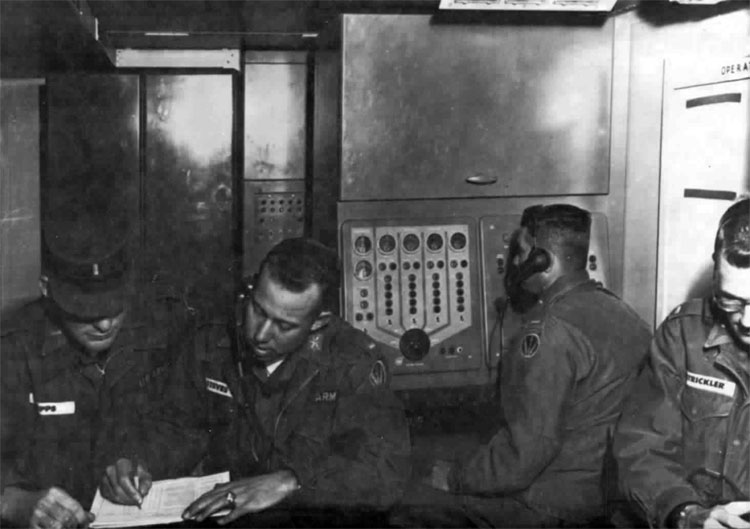
At the U.S. Army Air Defense School at Fort Bliss, Texas, student officers in a control trailer—the operational center of the system — prepare to test fire a Nike Ajax missile. AIR DEFENSE ARTILLERY MUSEUM.
After 1958, the Army constructed all Nike facilities with magazines designed specifically for the Nike Hercules, the "D" box. Nike Missile Base SL-40, constructed in 1958, had a "D" type magazine. During the transitional years, as Nike Hercules missiles were first coming on line, many batteries had a mix of Ajax and Hercules missiles. For example, between 1958-1961, Nike Missile Base SF-88L near San Francisco, held 5-6 Hercules missiles in launch section "A," and 10-11 Ajax missiles in launch section "B." This was typical of many Nike batteries across the nation.
j
Left and Opposite Page: As each successive generation of Nike missile became more sophisticated, so did the radar systems. The earliest low-power (LOPAR) acquisition radars (left). were later replaced and/or supplemented by high-power (HIPAR) radar systems (opposite page), which were capable of detecting intruding aircraft at further ranges and higher altitudes. SMITHSONIM.
Nike Zeus
Nike Zeus, the final Nike missile, was aimed at intercontinental ballistic missiles (ICBMs). Zeus was the third missile in the Nike family, and brought Nike development into the ICBM era. Named for the ruler of the Greek Gods, the Zeus missile measured 63 feet 3 inches, had a diameter of 60 inches, and weighed 40,000 pounds at launch. The tandem booster, designed by Thiokol, had a thrust of 450,000 pounds — then the highest ever attained through a single nozzle. The Zeus had a range of more than 250 miles. The Nike Zeus system also included the Zeus Acquisition Radar (ZAR). a significant improvement over the Nike Hercules HIPAR system. Shaped like a pyramid, the ZAR featured a Luneberg lens receiver aerial weighing about 1,000 tons. The first successful intercept of an ICBM by Zeus was in 1962. at Kwajalein in the Marianas Islands.[56]
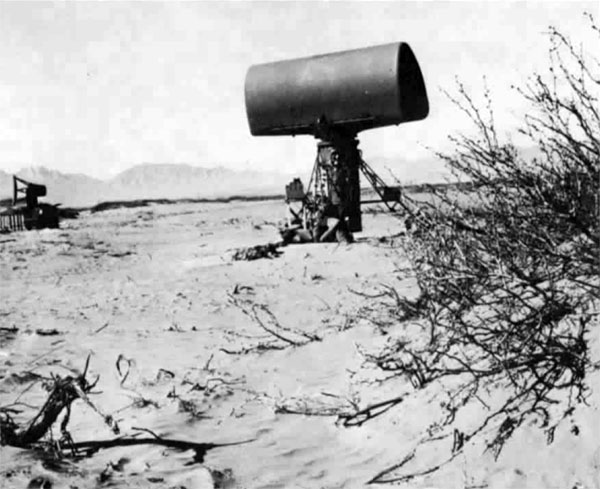
As each successive generation of Nike missile became more sophisticated, so did the radar systems. The earliest low-power (LOPAR) acquisition radars (above), were later replaced and/or supplemented by high-power (HIPAR) radar systems (below), which were capable of detecting intruding aircraft at futher ranges and higher altitudes (SMITHSONIAN).
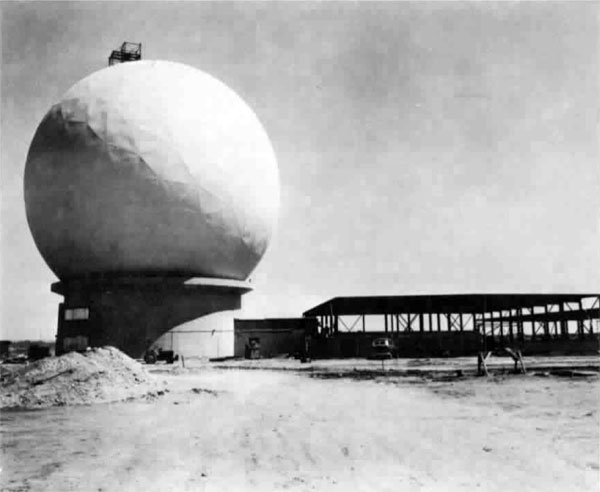
Despite its technological advancements, the Departmenj of Defense terminated Zeus development in 1963. The Zeus system, which cost an estimated $15 billion, suffered from several technical flaws, including an inability to distinguish enemy warheads from chaff, reflectors, and other types of decoys.[57] Still, the Army continued to develop an anti-ICBM weapon system - referred to as "Nike-X" — that was largely based on the technological advances of the Zeus system. Nike-X featured phase-array radars, computer advances, and a missile, tolerant of skin temperatures three times those of the Zeus In September 1967, the Department of Defense announced the deployment of the Sentinel antiballistic missile system, its major elements drawn from Nike-X development In March 1969, the Army deployed the Safeguard program, which was designed to defend Minuteman missiles, and which also was based on the Nike-X system.[58]
NIKE MISSILE BASES C-84 and SL-40
In 1955 Army designated 30 sites as top Nike installations, all located in in or near major cities: Washington-Baltimore, New York, Chicago, Detroit, Philadelphia, Hanford (Washington), San Francisco, Los Angeles, Seattle, Norfolk, Pittsburgh, and Niagara-Buffalo. The Department of Defense chose these sites because of their dense population, and industrial and/or military characteristics. In most cases, these sites were already protected by 90mm and 120mm antiaircraft guns.[59] Ultimately, the Army constructed approximately 300 Nike sites in 29 states: Alaska, California, Connecticut, Florida, Georgia, Hawaii, Idaho, Illinois, Indiana, Iowa, Kansas, Louisiana, Maine, Maryland, Massachusetts, Michigan, Minnesota, Missouri, Nebraska, New Jersey, New Mexico, New York, Ohio, Pennsylvania, Rhode Island, Texas, Virginia, Washington, and Wisconsin.
Originally, the Army intended Nike to be a mobile weapon system. As such, Nike's battery control and launching areas were to be above-round facilities, fulfilling the Army's requirements that the missiles be as mobile as antiaircraft guns. However, Army safety regulations also governed the surface storage of explosives. As a result, each Nike base required at least 119 acres of land. In October 1952, just three months before Nike equipment began rolling off production lines, Army personnel responsible for land acquisition realized that the needed acreage would be difficult to secure. The needed land was both costly and scarce, particularly if it was in or near metropolitan areas—the primary locations for Nike bases.[60]
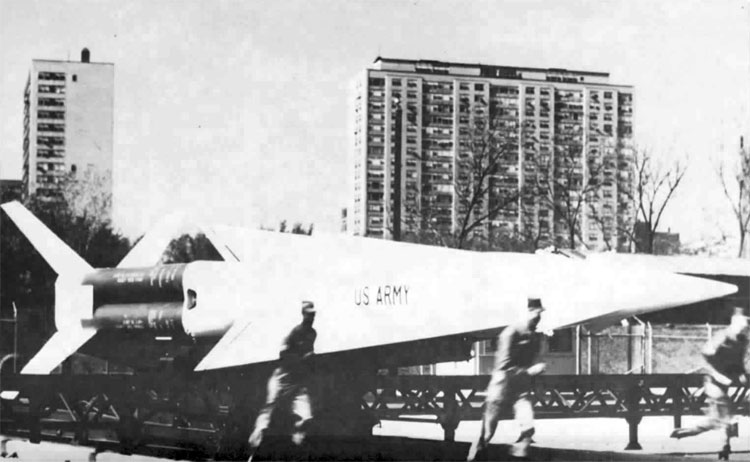
As the US. Army encircled the Chicago metropolitan area with Nike missile site installations, even the Windy City's j lakeshore became home to missile installation. REDSTONE ARSENAL.
In an effort to reduce the amount of required land, the Army examined the possibility of placing Nike launcher facilities in underground magazines. An underground installation decreased the real estate requirements to 40 acres of land. The feasibility of such a modification was confirmed during 1953, when a prototype underground Nike installation was built at White Sands Missile Range. Test firings proved successful in June 1953, and the Army decided to employ underground launcher installations at all Nike bases within the continental United States. Even though underground installations were chosen as the primary system, the Army continued to design the Nike system for dual application. One version was a fixed installation; the other was adapted to mobile field use. The mobile system, transported by road or aircraft, could be ready for action within seven hours after arriving at a base.[61]
Site Planning and Selection
Site selection for Nike facilities involved several phases of planning, design, and evaluation. A fundamental military principle was that a circular defense provided the best protection. As such, Nike installations ringed their protected cities and industrial centers — called, in military planning parlance, "vital areas." Each vital area was surrounded by a buffer zone. The size of each buffer zone was determined by the amount of damage the enemy could theoretically inflict, as related to the ability of the area to absorb damage and continue operating. Army experts soon found that no two sites were exactly the same. Although each Nike installation included essentially the same facilities, the configuration varied from base to base. Preliminary siting plans were sent to ARAACOM Headquarters at Colorado Springs, Colorado. These plans were then forwarded to the Pentagon for final approval.[62]
As part of the planning process for Nike deployment, Army technicians also plotted "bomb release lines" around each vital area. The horizontal distance that a bomb would fall forward from the release point to detonation depended principally on the speed and altitude of the releasing aircraft. By judging the possible altitudes and speeds of enemy aircraft, a critical line was determined around the vital area, beyond which the defense had to be able to destroy all enemy aircraft. The Army then determined the number of Nike installations required to effectively deny enemy penetration. Attack assumptions, defense characteristics, and command specifications were all taken into consideration. In addition, Army tacticians determined the number of missiles required at each site, evaluating such factors as prevailing climate conditions, technical support, crew proficiency, terrain difficulties, and maintenance schedules.
The Army placed Nike installations where they could best deter mass attacks from a single direction and, at the same time, maintain the most effective capability against multiple attacks from different directions. Utilizing a "defense in depth" concept, some Nike units were located well out from the vital area; others were close in. The location of the units was a compromise between moving inward to maximize firepower against a massed attack, and moving outward to increase effectiveness against multiple attacks. Ideally, the Nike installations offered mutual support — one Nike unit covering the "dead area" of its adjacent unit. [63]
The battery control area of each Nike installation, containing the guidance and control equipment, was between a minimum of one-half mile and a maximum of three miles from the associated launching area. The minimum distance was determined by the maximum tracking capability in elevation of the missile- tracking radar, and the maximum distance by practical considerations of providing communications by cables. A Nike installation's launchers made use of a common disposal area, within which the expended booster cases would fall. The Army was careful to select a booster disposal area that minimizes danger to Army personnel and property, as well as the surrounding civilian population. An adequate disposal area encompassed a circle of one-mile radius, with the center located about one and one-half miles from the nearest launcher section of populated area. [64]
Despite the reduced real estate requirements that resulted from the conversion to underground launchers, Nike installations fell behind schedule because of public opposition. No one particularly wanted “push-button warfare devices”, installed in their neighborhoods. [65] Civic officials, real estate groups, farmers, and homeowners objected to the installations for several reasons: fear of falling debris from booster cases, reduction in real estate values, damage ro crops, and the possibility of a missile misfire or explosion. [66]
Initially, the Army’s public relations problems stemmed, in part, from government security regulations that prohibited surveyors and engineers from disclosing why they wished to examine a landowner’s property. In some instances, land owners denied access to the surveyors. Eventually, Army officials realized they had to permit a "minimum of intelligence" to be released to area residents.[67] Press reports also raised concerns about the safety of the missiles. On April 6, 1953, Time magazine commented:
While doing their defending duty, the Nikes will not be desirable neighbors. The boosters that bounce them into the air are big enough to do damage when they fall to the ground, and so are the Nikes themselves...[68]
Eventually, the needs of national security prevailed and there seemed to be an understanding between the armed forces and the communities surrounding the Nike installations. In November 1955, the Chicago Sun-Times reported:
The reaction has varied from vigorous protest to indifference and ignorance of what is under way. But the Army is making a valiant public relations attempt to tell the public what it's up to and temper the shock of the American civilian population's first direct contact with radar and guns.[69]
The Army acquired most of the land through purchase, declaration of taking, and straight condemnation. Whenever possible, the Army utilized government-owned land, which also reduced cost and land acquisition concerns. On December 17, 1953, a Department of Defense press release stated that the use of government land could "reduce to a minimum, inconvenience to the civilian population and the removal of revenue-producing land from tax rolls."[70] In several cases, existing military bases converted to Nike installations.
Nike Missile Base C-84
The Army designated Chicago as Priority No. 3 for Nike Ajax installations, following Washington, D.C., and New York.[71] Prior to the construction of Nike bases to defend the Chicago area, antiaircraft artillery battalions, armed with 120mm and 90mm guns, were already present in and around Chicago. In April 1954, the Army Corps of Engineers advertised construction contracts for the first Nike bases in the Chicago area: C-93 (near Skokie), C-45 (Gary, Indiana), and C-51 (Alsip). Nike Missile Bases C-03 (Belmont Harbor), C-41 (Jackson Park), C-40 (Burnham Park), C-61 (Lemont), C-44 (Wolf Lake), C-80 (Arlington Heights), C-72 (Addison), C-49 (Homewood), C-92 and C- 94 (Libertyville), and C-98 (Ft. Sheridan) were deployed by 1957.[72]
In the Chicago area, the Army utilized park land for Nike installations as much as possible. Under lease arrangements, Nike installations were situated in Chicago's Jackson Park, Burnham Park, Lincoln Park, Belmont Harbor, and Montrose Harbor. In all, the Chicago Park District leased 88.5 acres of lake front land to the Army at the rate of $1.00 per year per site. Some local citizens criticized the loss of public recreation land and lack of compensation. On March 6,1956, Major General Carter, chief of the 5th Regional Antiaircraft Command at Fort Sheridan, told the Chicago Daily News:
We don't want to take any park land, but we have no alternative ... a circular defense of the city is best from a military point of view. In lake front cities like Chicago the defense must cut across the "diameter" of the circle, the lake shore. We make every adjustment possible without throwing defense out the window.
The Army acquired the land for Nike Missile Base C-84, which was approximately 25 miles northwest of Chicago near the town of Barrington, through a combination of purchase, declaration of taking, and condemnation. During 1956 and 1957, the Army acquired 26.87 fee acres, 54.67 easement acres, and two no-area permits (pole line and sanitary sewer line in public road right-of-way) for use as Nike Missile Base C-84. The Launch Area, which was just east of Quentin Road, consisted of 15.80 fee acres. The Battery Control Area, which was to the east just north of Lake Cook Road, contained 11.07 fee acres. Of the 54.67 easement acres, 0.19 acres were comprised of an access road and utility easement for the launcher and housing area, and the remainder of the 54.59 easement acres were line-of-sight and safety easements.[73]
The cost for Nike Missile Base C-84 was $1,214,502.97. By June 1962, the Army had constructed 12 Nike installations for the Chicago Defense Area, which cost $13,774,674.11 ($55,071.89 over budget).[74] In all, the Army built 23 Nike installations in the Chicago-Gary (IN) Defense Area, although they were not all in operation simultaneously.
Two Army battalions and the National Guard manned Base C-84. In 1956-1957, the 13th Antiaircraft Artillery Battalion — which earlier had been part of the Chicago defense system of 90mm and 120mm antiaircraft guns — was headquartered at Nike Missile Base C- 54 (Orland Park), and served as a Nike-Ajax battalion. On July 16,1956, the battalion designation was changed to 13th Antiaircraft Artillery Missile Battalion, Nike-Ajax. Also that month, D Battery transferred from Base C-71 (La Grange) to Base C-84. Battery A was located at Nike Missile Base C-70 (Naperville); Battery C was at Base C-51.[75]
The 13th Antiaircraft Artillery Battalion inactivated September 1,1958. At that time, the 2nd Battalion, 60th Air Defense Artillery, activated with headquarters at Nike Missile Base C-54. Through 1959, Nike Missile Base C-84 served as this battalion's Battery D. Battery A was located at Nike Missile Base C-49 (Home- wood); Battery C was at Nike Missile Base C- 46 (Munster, Indiana). By 1961, a National Guard unit manned Nike Ajax Missile Base C- 84.[76] By this time, Nike Hercules was the more advanced version of the missile, and several Nike Ajax installations in the Chicago defense system were converted to accommodate the larger and more powerful Hercules missile. However, Base C-84 was not converted. After the 2nd Battalion, 60th Air Defense Artillery became a Nike Hercules battalion, Battery D moved from Base C-84 to Base C-61 (Lemont).
NIKE MISSILE BASE C-84
BARRINGTON, ILLINOIS
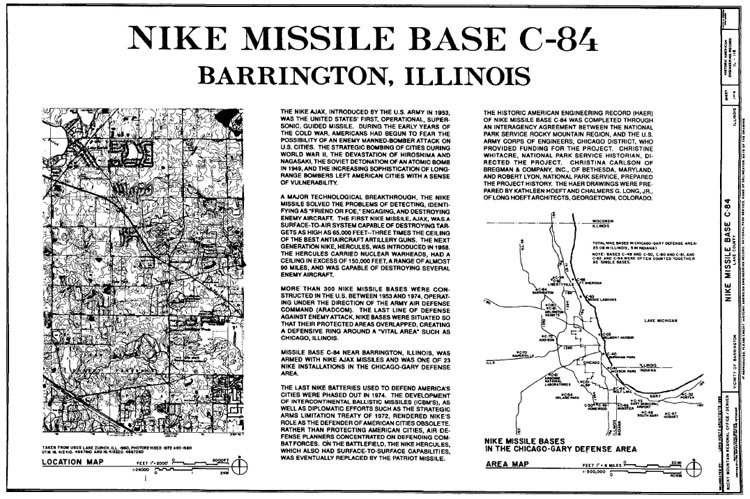
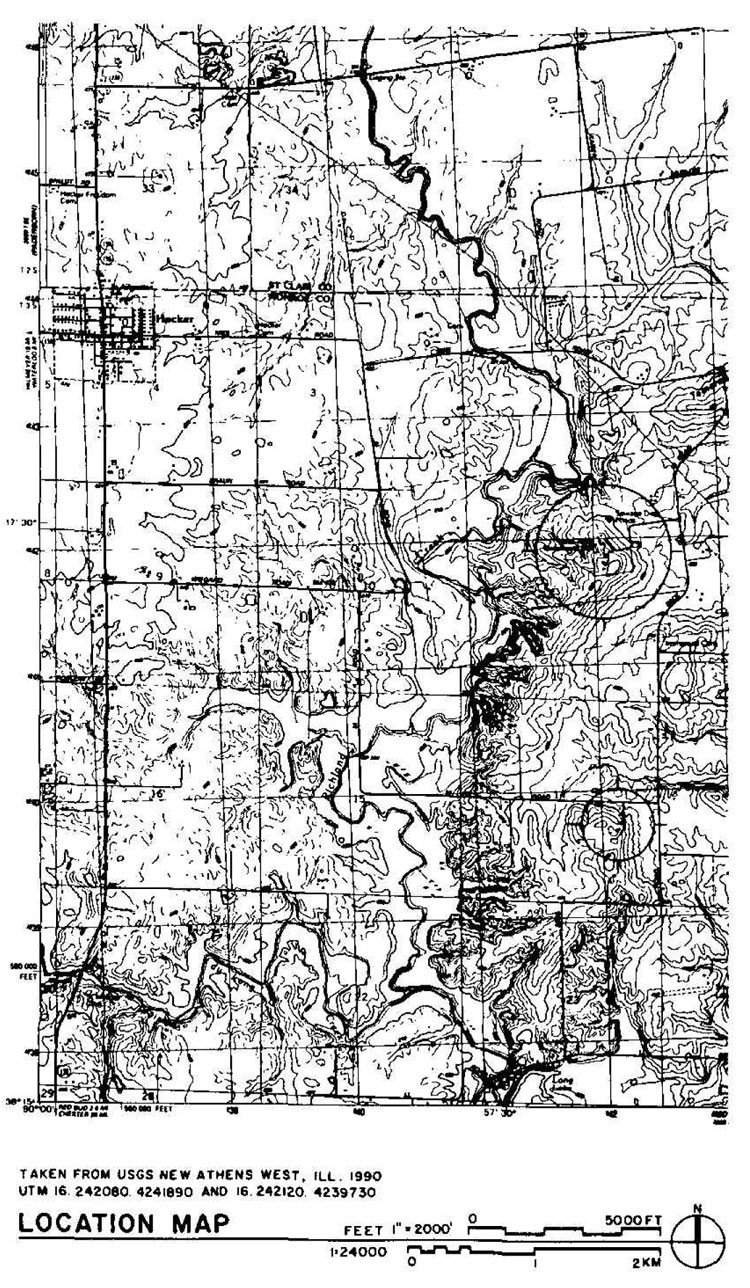
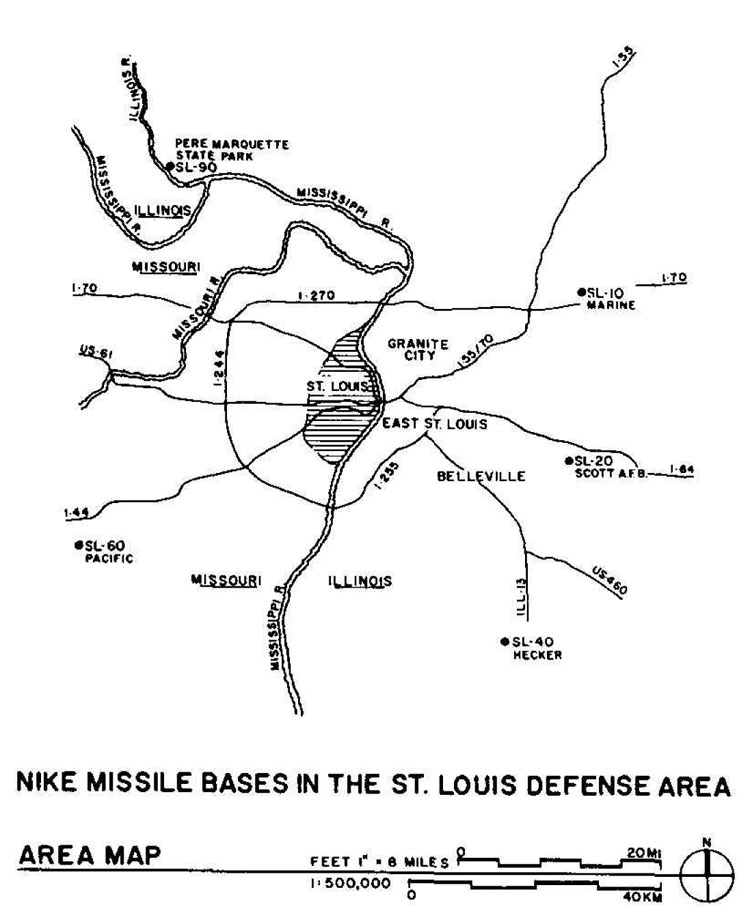
In 1961, Colonel R.E. Vollendorff wrote to U.S. Congresswoman Marguerite Stitt Church that "Nike Site C-84 is an active NIKE Ajax Site which is being manned by a National Guard Unit.''[77] Indeed, the Department of the Army planned for the Army National Guard to eventually man 50 percent of the missile sites in the air defense of the Nation.[78] In its 1961 annual report, the National Guard listed Chicago as one of 15 defense areas where Nike- Ajax batteries were operated by Guard units.[79]
Nike Missile Base SL-40
Initially, St. Louis, Missouri, was to receive only 90mm guns as its main defense against enemy aircraft. Since the mid-1950s, 90mm and 120mm guns had been a mainstay of air defense around America's major population centers. However, St. Louis officials fought to obtain the Nike Hercules weapon system. On February 4, 1956, the St. Louis Globe-Democrat reported:
Although St. Louis is listed officially as one of the "mostprobable targets for atomic attack, " there are no immediate plans to equip this area with anti-aircraft weapons capable of stopping Soviet Russia's best planes. This was disclosed to the Globe-Democrat yesterday by Army and Civil Defense authorities. The Army announced Thursday that anti-aircraft defense planned for St. Louis consists of 32 90-millimeter guns to be installed by mid-1957 and manned by National Guardsmen. The 90-millimeter weapons cannot bring down planes flying at 40,000feet or beyond the speed of sound. Such ships can be tracked and destroyed by the Nike guided missile. "To our knowledge, there are no immediate plans to bring the Nike to St. Louis," said Lt. Col J.H. Farren, executive officer of the Army Central Anti-Aircraft Regional Command at Grandview Air Force Base, south of Kansas City. "We are basing our plans for St. Louis on a 90-millimeter defense, and not a missile defense. In two or three years, St. Louis might get something better.[50]
About one month later, U.S. Congressman Frank M. Karsten from St. Louis asked that "St. Louis be put on the priority list of cities which will receive Nike guided missiles for defense against hostile aircraft," or at least have 120mm guns installed instead of the older 90mm guns.[81] Based on the information available, Karsten's arguments proved effective. Two weeks after his complaints were printed, the Defense Department informed Karsten that it was asking the Army to resurvey the St. Louis defenses.[82]
In May 1956, the people of St. Louis learned that the deployment of Nike Hercules batteries around their city might occur within the next two years. Until that announcement Army officials had been somewhat vague about air defense plans for St. Louis, committing only to the 90mm guns. There was some speculation that the Army chose to announce the deployment of Nike missiles because of Air Force promises that the air approaches to St. Louis would be protected by its Talos and BOMARC missiles.[83]
Four sites were chosen for the installation of Nike Hercules missile facilities for the St. Louis area: one near Pacific, Missouri, and the three others in Illinois, at Hecker, Marine, and Pere Marquette State Park, near Grafton. Each site is located about 35 miles from St. Louis. The headquarters for the battalion deployed at St. Louis was Scott Air Force Base, near Mascoutah, Illinois. The bases were built under the supervision of the Chicago District of the Army Corps of Engineers.
NIKE MISSILE BASE SL-40
HECKER, ILLINOIS
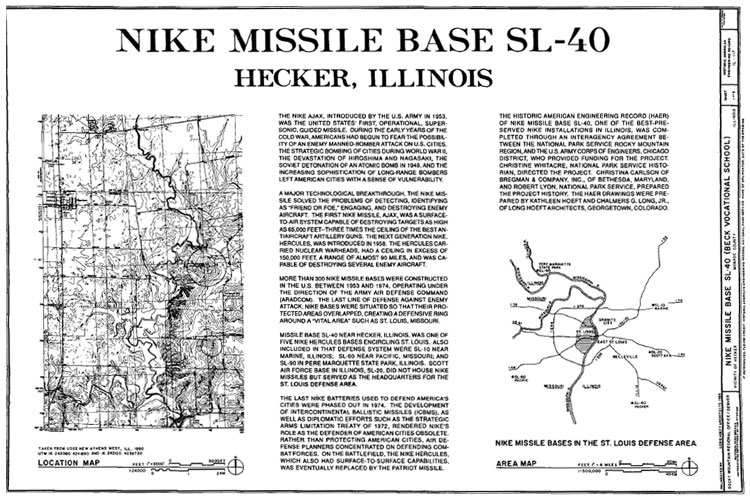


One Nike Hercules battalion served the S. Louis Air Defense System. The 62nd Air Defense Artillery, 1st Automatic Weapons Missile Battalion activated June 1, 1959, at St. Louis, Missouri, under the command of Lt. Col. Robert H. Zimmermann. [84] It was redesignated December 20, 1965, as the 1st Battalion, 62nd Artillery, and activated January 15, 1969, at Scott Air Force Base, Illinois. Throughout this time, Scott Air Force Base (SL-20) served as the battalion headquarters. Battery A was located at Marine, Illinois (SL-10). Battery B was at Hecker, Illinois (SL-40), Battery C was at Pacific, Missouri (SL-60), and battery D was located at Grafton, Illinois (SL-90). The St. Louis Defense System was under the 5th ARADCOM Region jurisdiction until 1966, when it came under the 2nd ARADCOM Region, where it remained until the closing of the Nike bases surrounding St. Louis in 1968.
The land for the Hecker base (SL-40) had previously been used for farming. In 1958, the Army purchased the land from Charles "Pete" Strautz, a local farmer. The installation encompassed a total of 227.71 acres. The three noncontiguous parcels of land were comprised of: 34.28 fee simple acres (20.12 acres for the Housing and Control Area; 14.03 acres for the Launcher Area; 0.13 acres for the well site); 193.18 easement acres (line-of-sight and safety easements); and 0.25 acres leased for a water line.[85] According to the Disposal Plan for Base SL-40, the acquisition cost for this site was $2,638,800. Land costs were $22,450; improvements were $2,600,850; and personal property $15,500.
The Army began constructing Nike Missile Base SL-40 in June 1958 and finished one year later, at which time the 62nd Artillery, 1st Missile Battalion, was activated. M.H. Wolfe & Co. and J.J. Altman & Co. of East St. Louis were the contractors for the Marine base (SL- 10). Fruin-Colman Contractors Co. of St. Louis was the primary contractor for the remaining St. Louis bases, including SL-40. Warren & Van Praag, Inc., of Decatur, Illinois, served as a consultant.[86]
SITE DESCRIPTIONS
The buildings and structures at each Nike base were organized into two basic parcels: the Battery Control Area and the Launch Area. The Launch Area contained the underground missile storage magazines and launch equipment, well as buildings used for maintenance and testing. The Battery Control Area contained the radar and computer equipment. Housing and administration buildings, including the mess hall, barracks, and recreation facilities, were sometimes located in a third parcel of land. More likely, however, the housing and administration buildings were located at either the Batteiy Control Area or the Launch Area, depending upon site configuration, obstructions, and the availability of land. At Nike Missile Base C-84, the housing and administrative buildings were located in the Launch Area. At Nike Missile Base SL-40, the Launch Area was separate from the combined Housing, Administration, and Battery Control Area. All Nike buildings and structures were built from standardized drawings approved by the Corps of Engineers, which were adapted to each individual missile base.
The building descriptions and arrangements listed below are based on Nike Missile Bases C-84 and SL-40. It must be noted, however, that structure types and numbers varied from base to base.
Housing, Administrative, and Support Buildings
In 1955, the standard Nike Ajax battery consisted of 106 officers and enlisted men. By 1960, that number increased to 115 men.[87] The buildings and structures that housed these crewmen were also standardized, although (like the number of crewmen) there were variations. Initially, the Army considered the use of pre-fabricated buildings for Nike installations, but the Army found that they were unsightly and did not contribute to troop morale. As a result, the Army constructed more substantial buildings that were of "modified emergency" type design. Typical of most Nike missile installations, Nike Missile Bases C-84 and SL-40 each included sentry guardhouses, an administration building, barracks, mess hall, a basketball court, and various storage sheds. Most of these buildings were vernacular, one-story structures with cinder-block walls and slanted metal roofs.
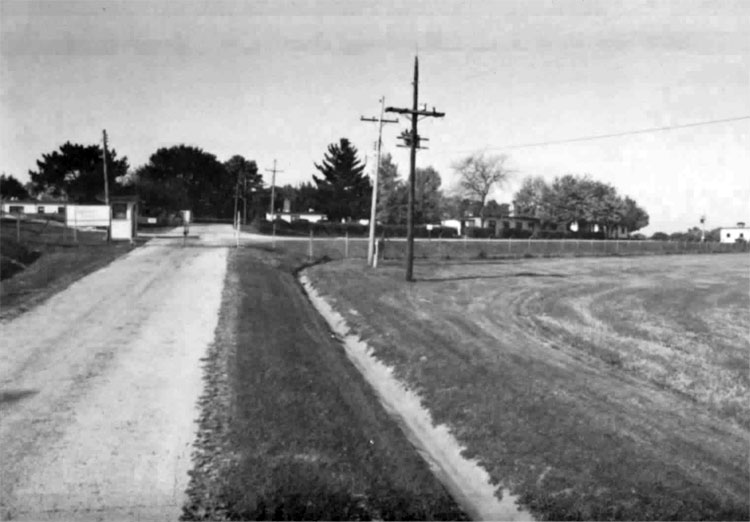
Overview of the entrance to the Battery Control Area of Nike Missile Base SL-40. ARNOLD THALLHEIMER.
Sentry Guardhouse: Sentry guardhouses — small, square structures with cinder-block walls — were at the entrances to all portions of a Nike missile base. In addition, as part of base security, two lines of fencing and a firebreak marked the boundaries of the installation.
Administration Building: The administration building housed the administrative support services for the base. The one-story, cinder-block building included a day room, offices for the battery commander and officers, a supply room, a supply office, hobby room, communications room, barber shop, mail room, restroom, and arms storage room.
Barracks: Nike Missile Bases C-84 and SL- 40 each contained two barracks buildings, which provided living quarters for base personnel. Typical of most Nike installations, one barrack was for launch personnel, the other was for the battery control crewman. The construction drawings indicate that each barrack contained an officers' lounge, non-commissioned officers' lounge, several storage rooms, heater room, restroom, shower room, and large common sleeping room. The barracks, which had cinder-block walls and slanted roofs, were one-story buildings with "L"-shaped floor plans.
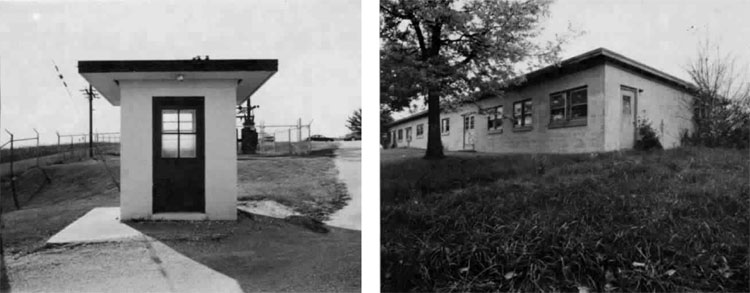
(Left) Security fencing surrounded Nike missile installations, and visitors were required to stop at the sentry guardhouse located at the entrance of each site. (Rite) Administration Building, Nike Missile Base C-84 All of the Nike buildings were built from standardized designs: most of the housing and administration buildings were one- story, cinder-block buildings, ARNOLD THALLHEIMER.
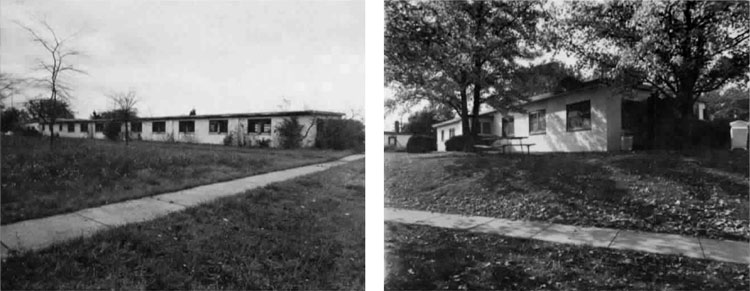
(Left) Barracks. Nike Missile Base C-84. (Right) Mess Hall. Nike Missile Base SL-40 ARNCMD THALLHEIMER.
Mess Hall: The mesa hall was the common eating facility for personnel stationed at the base The building included a kitchen, dining area, storage area, and boiler room. The building had cinder-blocks walls, a slanted roof, and two entry vestibules.
Paint and Oil Shed: The paint and oil shed was very similar in design to the sentry guard-house, a small square structure with cinder- block walls.
PX (Supply Store): Nike bases often included a PX (Supply Store); the store at Nike Missile Base C-84 is a gable-roofed rectangular building, with sheet metal walls and roofing.
Water Treatment/Sewage Facilities: Typical of all Nike missile installations, Nike Missile Base C-84 and SL-40 both had their own water treatment and sewage facilities. Depending on location, these base facilities might include wells, pump-houses, sewage lagoons, holding tanks, and/or septic tanks.
Basketball Court: When not on alert, Nike crewmen reported that life at a Nike missile installation could be tedious. In order to provide some recreational opportunities, the Army equipped each base with a basketball court. In addition, crewmen often played team sports, such as softball, with servicemen from other nearby bases or with teams in the surrounding communities.
Battery Control Area
The Battery Control Area — often referred to as the Integrated Fire Control (IFC) Area — included all of the necessary radar, computer, and control equipment needed to detect and identify a target, and to launch and guide a missile to intercept that target. In general, the Battery Control Area was located on higher terrain that was relatively level and well-drained. Since this area contained all of the Nike equipment, the location also had to be free of any visual obstructions such as trees, radio towers, power and telephone lines,[88] The Battery Control Area a minimum of ten servicemen to operate, and was the focal information and communications point for the battery. Communication cables connected the various elements within the Battery Control Area, as well as with the Launch Area. The major structures within the Battery Control Area included:
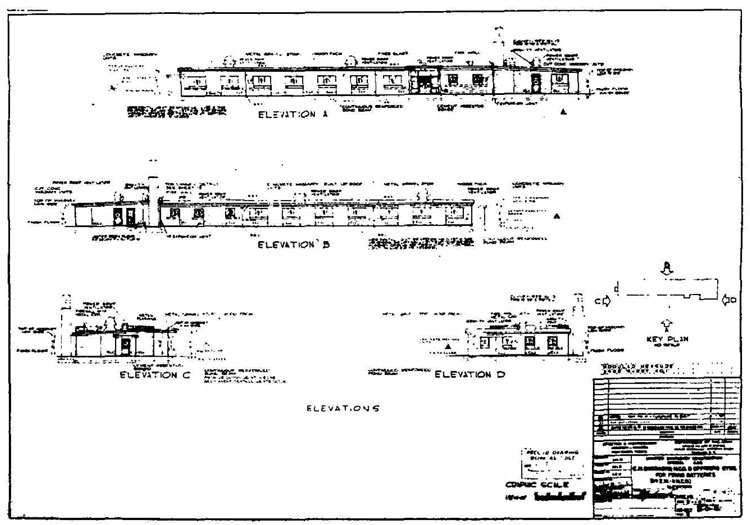
Construction drawing for barracks, Nike Missile base SL-40.
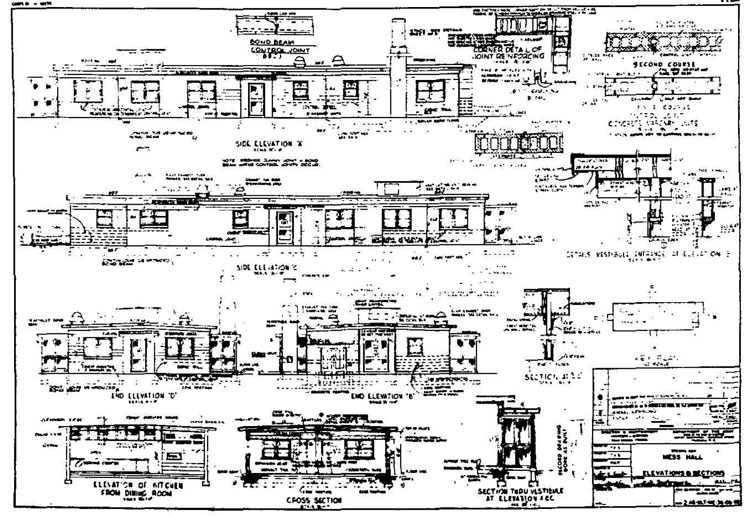
Construction drawing of messa hall, Nike Missile Base SL-40.
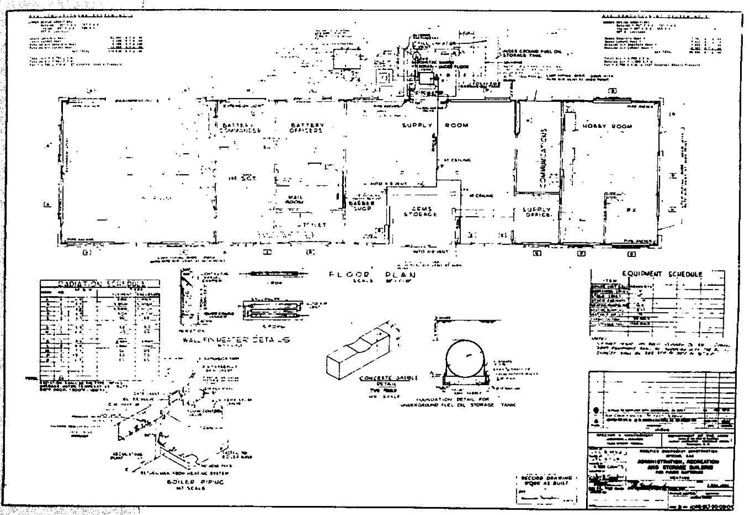
Floor plan of administration building, Nike Missile base SL-40
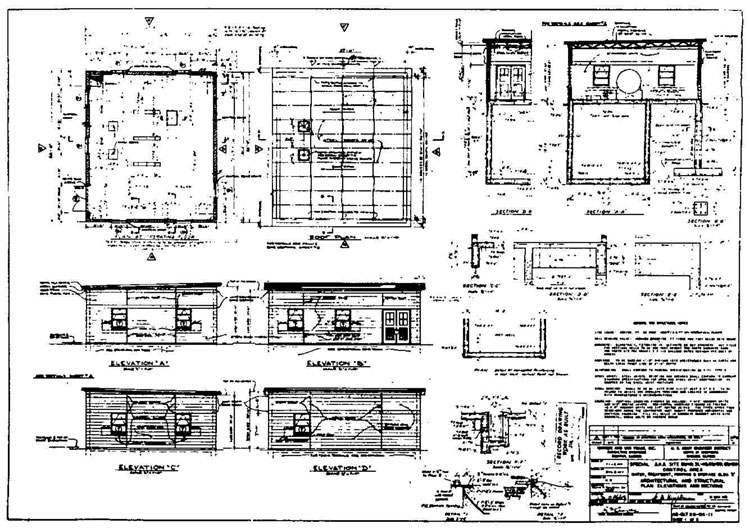
Plan, elevation, and sections of water treatment building, Nike Missile Base SL-40.
Battery Control Trailer: The Army originally designed Nike to be a mobile system that would be suitable for use with a field army. As deployed for continental air defense, Nike bases were permanent installations. However, the military still wanted the system to be suitable for field use. As a result, the key pieces of the Nike weapon system's radar, launch, and battery control equipment were in mobile trailers connected through communications cables. Other trailers were used for spare parts, maintenance, and antenna equipment. "It appeared more reasonable," noted an Army training manual, "to adapt the mobile equipment for use in a fixed type of installation rather than to redesign the equipment specifically for fixed installations. The latter would be costly and time-consuming and it offered no promise of operation improvement or substantial ultimate economy."[89]
The battery control trailer was at the heart of the Nike missile system. The Army equipped the trailer so that it would provide the battery control officer all the information required to direct the battery. The trailer contained the battery control console assembly, the acquisition radar cabinet assembly, the computer assembly, an early warning plotting board, an event recorder, and a switchboard cabinet assembly. From this trailer, the battery commander directed the acquisition of targets and the firing of the missiles. The acquisition radar operator and computer operator also were stationed in the battery control trailer.90 (Note: Prior to the recordation of Nike Missile Bases C-84 and SL-40, all equipment and control trailers were removed.)
Radar Control Trailer: The radar control trailer (often referred to as the central tracking trailer) housed the target radar console assembly, the missile-tracking radar console assembly, the radar power cabinet assembly, the radar range and receiver cabinet assembly, and additional equipment associated with the target and missile-tracking radars. The target- track console assembly provided the control and displays necessary for the operation of the target-tracking radar. The missile-track console assembly provided the control and displays for the operation of the missile-tracking radar.[91] Generally, the battery control trailer and the radar control trailer were positioned back-to- back, which allowed easy access to both trailers by operating personnel. The maximum distance between the trailers was 25 feet.[92]
Low-Power Acquisition Radar (LOPAR): The LOPAR search radar was composed of the acquisition antenna, receiver, and transmitter. The radar rotated constantly at a predetermined speed. Through the acquisition radar scope, the battery commander (or battery control officer) received a pictorial image of a potential enemy target coming within range of the Nike installation. The battery commander, through electronic interrogation, could determine whether the target was "friend or foe."
Generally, Nike radars were mounted directly onto concrete pads. In some cases, because of visual obstructions, it was necessary to mount the radars on towers. These towers consisted of steel-reinforced concrete columns sheathed in aluminum for even heat distribution.[93] The acquisition radar was positioned between the target-tracking and missile-track- ing radars, although not in exact line with them.
High-Power Acquisition Radar (HIPAR): This radar, which was installed at Nike installations equipped with Hercules missiles, was capable of locating targets at much higher altitudes than the LOPAR system. Since a ballistic missile or high-speed plane may not have been detected until it entered the antenna beam, high-altitude coverage was necessary to give adequate reaction time to allow for an intercept at a safe distance. Some bases also included an Alternate Battery Acquisition Radar (ABAR).[94] The HIPAR was often located on a support and tripod structure, often as high as 50 feet. A dome-shaped cover, known as a radome, surrounded the radar and various antennas . There were usually three types of antennas: the main, omni, and auxiliary antennas.
HIPAR Equipment Building: This building was adjacent to the HIPAR, system and housed electronic equipment necessary to operate and maintain the HIPAR radar.
Target-Tracking Radar. The target-tracking radar tracked the enemy aircraft's range, direction and elevation, and transmitted this data electronically to the computer. The radar was composed of the tracking antenna, receiver, and transmitter.
Missile-Tracking Radar: This radar was very similar in appearance and operation to the target-tracking radar. The missile-tracking radar tracked the missile throughout its flight, and continuously sent that information to the Nike installation's computer system. In turn, the computer transmitted steering commands to the missile through the missile-tracking radar to direct the missile toward its predicted intercept point with the target. Continuous commands were sent to the missile to correct for evasive actions by the target. When target and missile converged, the missile was detonated and the missile-tracking radar automatically transferred to the next missile readied for firing.
Generator Building: The generator building housed diesel-driven generators for power to operate the area during periods when commercial power was not available. Transformers were mounted outside the building for utilization of commercial power. Commercial power, with electrical converters to change 60- cycle power to 400-cycle power, was utilized where available. Power source switching control also was provided at this point.
Radar Collimation Mast Assembly: The radar collimation mast assembly was composed of: the radar test, which had two track-radar frequency band generators; the radar collimation mast, which was usually about 60 feet tall; the targethead assembly; and cross arms, for correcting bore-sight. The mast assembly was used for collimating (adjusting the line-of- sight), testing, and adjusting the missile-tracking and target-tracking radars. Typically, the mast assembly was located approximately 600 feet from the missile-tracking radar and the target-tracking radar. Spatially, the mast assembly and the two tracking radars formed a tall triangle.
Launch Area
The Launch Area provided for the maintenance, storage, testing, and firing of the Nike missiles. The selection of this area was primarily influenced by the relatively large amount of land required, its suitability to extensive underground construction, and the need to maintain a clear line-of-sight between the missiles in the Launch Area and the missile-tracking-radar in the Battery Control Area.[95] At Nike Missile Base SL-40, the Launch Area included a sentry guardhouse, a ready building for the crew, a water treatment building, a missile test and assembly building, a warheading building, a generator building, a canine kennel, an acid fueling station, an acid storage shed, and three missile launching sections, each equipped with four missile launchers. An estimated 21 men, including the launching control officer and the section chief, operated launch control. Of these, six missile crew members manned each of the three launching sections.[96]
The following descriptions are based on the launch areas at Nike Missile Bases C-84 and SL-40. As noted above, actual launch site buildings and arrangements varied throughout the Nation.
Launch Control Trailer (LCT): The launch control trailer contained the necessary equipment to function as the control center between the battery control trailer and the launching sections. Similar in appearance to the battery control and radar trailers in the Battery Control Area, the launch control trailer contained the launching control panel, the launching control switchboard, and test responder. Included within the launching control panel were the controls, displays, and communications equipment that were needed to supervise and monitor the launching sections, and to act as a relay station between the launching sections and the Battery Control Area.[97]
Missile Test and Assembly Building: Missiles arrived at Nike bases unassembled and unarmed, as peacetime Interstate Commerce Commission restrictions prevented the transporting of ready missiles from a central assembly site.[98] In the Missile Assembly and Test Building and its adjacent hardstand, Nike crews uncrated, assembled, and tested the missiles. Missile "assembly" referred primarily to the installation of the missile control fins, main fins, ailerons, and fairings. The missile's hydraulic and propulsion systems were also checked. The crew visually inspected the various components and lines of both systems for correct assembly and serviceable condition. Crewmen also ran leak tests on the missiles’ lines and cot lponents."[99]
Following the system tests, the crew performed a complete missile test. In preparation for this test, crewmen connected the missile to an external source of hydraulic power and to the radio frequency and electrical test sets. The missile was then operated from these external sources. In effect, the missile was made to perform as it would in flight and its performance was carefully observed. After this test, the crew connected the missile to a compressed air source, and both the hydraulic air tank and the propulsion air tank were pressurized. The crew installed a charged battery in the missile guidance section, and conducted a pressure test to assure that it was properly sealed.[100]
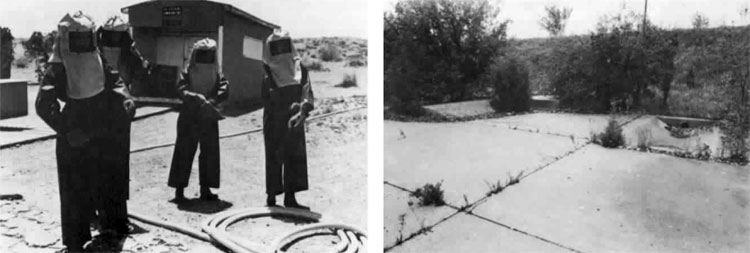
(Left) Crewmen in protective suits working with corrosive liquid fuels used in Nike Ajax missiles. AIR DEFENSE ARTILLERY MUSEUM. (Right) Opposite Page, Right: Acid Fueling Station. Nike Missile Base C-84. ARNOLD THALLHEIMER.

(Left) Construction drawing for Warheading Building. Nike Missile Base SL-40. (Right) Warheading Building, Nike Missile Base SL-40. ARNOLD THALLHEIMER.
Nike Hercules.
Underground storage magazine and launcher-loader assemblies
The Missile Test and Assembly Building had two large, garage-like doors at either end, through which the missiles were rolled in and out. In addition to the main test and assembly room, the building included a stock room, first aid room, restroom, and boiler room. A concrete walkway for missile movement connected the Missile Test and Assembly Building with the acid fueling station.
Acid Fueling Station: At the acid fueling station, crewmen fueled and joined the missile to the booster. The servicer that fueled the missile was a crank-operated lift approximately 12 feet high. Crewmen hoisted the fuel onto this platform, allowing the fuel to flow into the missile by gravity. Likewise, the acid servicer had an assembly that automatically inverted the barrel as it was raised."" As protection against the caustic acid, crewmen wore rubber suits during the fueling process.
Acid Storage Shed: Located near to each acid fueling station was a metal storage shed. Also located nearby were shower facilities, in the event of accidental contact with dangerous chemicals and fuels.
Warheading Building: For safety in the event of explosion, the missile warheading operations were also performed at the acid fueling station, which was encircled by an earthen berm approximately eight to ten feet high. The warheading process basically involved installing two armng devices, the warheads, and connecting these components with the detonating cord.[102]
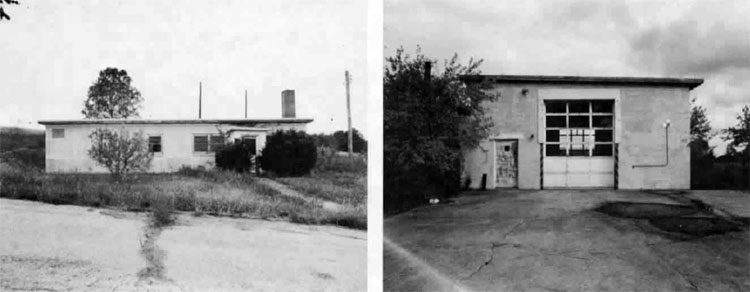
(Left) Ready Building. Nike Missile Base SL-40 ARNOLD HALLHEIMER. (Right) The Missile Test and Assembly Building. Nike Missile Base C-84. ARNOLD THALLHEIMER.

(Left) Canine kennel Nike Missile Base SL-40 Guard dogs were an integral part of the security measures taken at Nike installations. (Right) During the day, military policeman and guard dogs patrolled the Nike missile bases; at night, the dogs were sometimes allowed to roam the launch areas, AIR DEFENSE ARTILLERY MUSEUM.
At Nike fissile Base SL-40, which had Nike Hercules missiles, the crew attached the warheads in the Warheading Building, which was located near the fueling station. Nike Missile Base C-84, which was equipped only with Ajax missiles, did not include a separate Warheading Building. This was typical of most Nike Ajax installations. For example, when Nike Missile Base SF-88L near San Francisco was equipped solely with Nike Ajax missiles, the missile test, assembly, and warheading activities all took place within the same structure. After the base acquired Hercules missiles, crewmen used a prefabricated metal building for missile test and assembly, and a separate building for warheading.
Underground Storage Magazines and Launcher-Loader Assemblies: Although they were originally designed to hold six magazines, Nike Bases C-84 and SL-40 each had only three underground storage areas, designated as letters A through C. Each unit had associated launch pads, access areas, and ground electrical units. The magazine pad had a double elevator door, which swung down to open. Stairways led to the double-door main entrances to the magazines. (Access to many Nike magazines was solely via armored hatches and vertical ladders. The staircases were later additions, which many Nike installations never received.) Emergency escape hatches, with counter-weights for easy opening, led from the underground personnel rooms to the inside. The magazines were made of reinforced concrete; fresh air was provided via a ventilation unit. Each unit also had several ventilator shafts.
Each underground unit contained a room for storing the missiles (the magazine room), an elevator to carry the missiles to the surface for firing, and four launcher-loader assemblies. Three of the launchers, numbers 2 through 4, were permanently emplaced above the ground and were referred to as satellite launchers. The fourth launcher (number 1) was mounted on the elevator. When the elevator was in its lowered position, the missile crew pushed a missile and booster from the storage racks onto the launcher on the elevator. When the elevator was raised, the missile and booster on the elevator could be pushed from the elevator launcher onto the satellite launchers. Nike crewmen could operate the elevator, which could be raised, lowered, or stopped, via a master control station in the magazine room, from the controls on the elevator, or from the launching section control panel in the personnel room. Hydraulic power operated the elevator, and the doors were supplied by an elevator assembly power unit in the magazine room.[103]
During "alert stages," servicemen stationed at Nike Missile Base SL-40 stayed in the personnel room of the underground launch area. The personnel room, which was equipped with bunks, was separated from the magazine by three blast-proof doors. An emergency escape hatch provided direct access to the outside. During an alert, after a launching section was placed "on deck," the launcher crews completed their checks of the missiles and launchers and went to the underground personnel room for safety.[104] (Most Nike magazines apparently did not have personnel rooms. The crew stayed in a nearby "ready room" within quick response distance. The only protected room was a small "panel room" that contained the section control panel and just enough space for a crew to stay in during actual launch.)
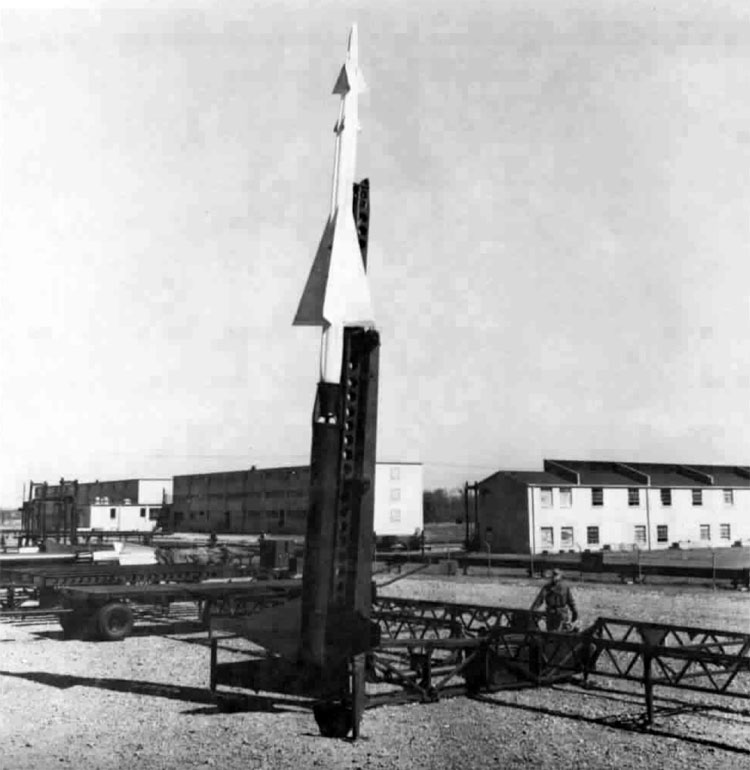
Nike Ajax missile on launcher-loader assembly. REDSTONE ARSENAL.
Generator Building: At Nike Missile Bases C-84 and SL-40, electric power for the underground magazines was supplied by 150-kilowatt, 60-cycle diesel generators, or commercial sources when available. Direct 60-cycle power was used for the elevator. Where 400-cycle power was required, the 60-cycle power was converted to 400-cycle power by means of frequency converters (changers).
Ready Building: The launch Area at Nike Missile Ban SL-40 was located approximately one and one-fourth mile from the combined Housing. Administration, and Battery Control Area. As a result, the Launch Area also included a ready building for the crewmen. Typical of most Nike base buildings, the ready building was a vernacular, one-story structure with cinder-block walls. The building included a squad room, a dining and day room, toilet, and heater room.
Canine Kennel Area: Guard dogs were an important part of a Nike missile base's security system, as military patrolman and dogs patrolled the base. At Nike Missile Base SL-40. the kennel was a small, gable-roofed, metal building, surrounded by chain link and barbed-wire fencing The kennel held training equipment. Leashes, dog food, and grooming tools. Nike canine areas also often included a dog training area, equipped with jumps and barricades.
Prior to the HAER recordation of Nike Missile Base S-84 and SL-40, the control and radar equipment had been removed. This interpretive drawing is a partial reconstruction of Nike Missile Base SL-40, and illustrates the basic operations involved in identifying, tracking, & firing at enemy aircraft.
NIKE OPERATIONS
The Nike system was part of the joint American-Canadian North American Air Defense (NORAD) and the U.S. Continental Air Defense Command (CONAD). Within NORAD, the Canadian and American air forces were responsible for detecting, identifying (as friend or foe), and destroying or turning back targets. The detection phase began with the identification of intruders through the Distant Early Warning radar system, commonly known as the DEW Line. The DEW Line, designed to give warning of hostile aircraft approaching from the north, consisted of a net of radar stallions near the 69° north parallel that initially extended from northwestern Alaska to northeastern Canada.
The United States and Canada jointly built and operated the DEW Line. The DEW Line became operational on July 31,1957, extended 10 Aleutian Islands in 1959, and across Greenland in 1961. The U.S. Navy and U.S. Air Force provided sea flanks for the DEW Line with radar-equipped aircraft operating from the Aleutian Islands to the mid-Pacific and from Newfoundland to the mid-Atlantic. The DEW Line provided up to six hours of advance warning of aircraft penetrating the northern hemisphere, complementary to the Ballistic Missile Early Warning System (BMEWS), which since June 1961 had been on guard to detect approaching ballistic missiles.
The DEW Line also alerted the back-up defenses of NORAD, including the Mid-Canada (55th parallel) and the Pine Tree (49th parallel) radar warning and control lines. The Mid-Canada Line was about 600 miles to the south, built and manned by Canada, and used Doppler detection equipment. The U.S. contiguous radar system was extended offshore by the Navy, as well as by Air Force radar-equipped aircraft. In the Atlantic Ocean, Air Force radar platforms (Texas Towers) were part of a system that was tied together by a communication network terminating in the NORAD command post.
The Semi-Automatic Ground Environment (SAGE), an Air Force command and control system, received all data from these radar networks. SAGE centers were located in several sectors and attempted to identify the intruders and transmit intruder locations to the appropriate Air Force and ARADCOM control and direction centers. Hypothetically, when an enemy intruder entered the band of contiguous radar coverage overlapping the United States- Canadian border, SAGE would initiate attack by sending fighter-interceptor squadrons and launching BOMARC missiles. If the area defense provided by these weapons failed, SAGE continued tracking the intruder and passed this information to ARAACOM Nike fire units. Nike batteries then came into play as "the ultimate defense" of the protected localities.[105]
Once notified of an intruder, ARAACOM would alert the appropriate Army Air Defense Command Post which, in turn, would designate one or more Nike batteries to attack the incoming target. The Nike system utilized a command guidance type of control system that revolved around the use of several types of radars and a computer. The target was initially picked up by the Nike acquisition radars, the LOPAR (low-power radar) or HIPAR (high-power radar in the Hercules) systems. From the information provided by the acquisition radar, the target-tracking radar acquired the designated target and tracked it throughout the engagement. The missile-tracking radar locked on the missile prior to firing, and tracked that missile throughout its entire flight.[106]
The two tracking radars fed target and missile position data into a computer located in the battery control trailer. Using this information, the computer continuously determined a predicted point of intercept and issued the steering orders that guided the missile toward that point. At the point of "highest kill probability," the computer issued a burst order to the missile. This order simultaneously detonated the three warheads in the Nike Ajax, and the single warhead in the Nike Hercules. The computer transmitted this order to the missile through the missile-tracking radar.
The battery control officer, stationed in the battery control trailer, received all of the information and controls necessary to engage the enemy target. A series of lights and a meter showed the officer the number of missiles prepared for firing, and the progress of the fire unit in accomplishing the steps necessary to prepare and fire the missile. Prior to firing, the predicted point of intercept and the current position of the target were continuously displayed on two plotting boards in the battery control trailer. With this information, and knowing the rules of engagement and the restricted areas, the battery control officer determined the most advantageous time to fire the missile. After the missile was fired, the two plotting boards illustrated the course of the target and the missile flight path. These plots provided the battery control officer with a graphic presentation of the missile and target flight paths. Controls necessary for premature or delayed detonation of the warheads were incorporated into the system.
The Nike system operated with four batteries in one battalion. Each battery could acquire and track targets, as well as launch and control missiles. Each battery had three underground storage facilities, which had the capability of firing one missile from the elevator/ launcher and three others from satellite launchers loaded from the same facility. As sophisticated as the Nike missile was, however, each battery could only track and fire one missile at a time.
Firing a Missile
Once the Army Air Defense Command Post received word of an impending attack, it notified its battalions. As the target entered the range of the acquisition radar and the missiles at each battery readied for launch, a "blue alert" status sounded, signaling that all personnel should go to battle stations. Three missiles were brought above ground, one at a time, on the elevator, and pushed to the satellite launchers and locked in place with pins. The fourth missile was brought to the surface on the elevator,[107]
The chief of the launching section removed the air regulator safety pin and the missile support yoke safety pin. The launching crew checked for stray voltage and continuity at the detonator on the launchers with the squib (or detonator) tester. If test readings were within acceptable tolerances, the launching crew made the connections and removed the booster squib shorting plug. The chief of the section then announced over the intercom: I, 2, 3, and 4 ready."
An Army film on Nike Hercules provides a visual re-creation of the firing of a missile. Safety was the central theme stressed in the film. Among the precautions that were employed were a series of color-coded streamers attached to critical plugs and keys. For example, red streamers were attached to those parts that had to be removed before missile could be launched. Even when the streamers were removed, personnel had to use special keys to unlock the "awesome power" of the missile system.[108]
After preparing the missiles for launch and checking the area to ensure all personnel were below, the section chief descended into the underground personnel room, closing the escape hatch cover behind him. The section chief then entered the magazine room, closed the vents, and returned to the personnel room, securing the blast-proof doors. He checked the pin board to ensure that all the safety pins and the booster squib shorting plug were present. At that time, he also inserted the crew safety keys and placed them in the "fire" position. At the launching control console, there was a green "ready" light for each section, and a green numbered launcher identification light for each section in action. The "missile prepared" meters for each section indicated the number of missiles ready for launch in each section.
As the target came within range of the acquisition radar, the battery control officer corroborated the target appearing on the plan position indicator with the early warning plot data received from the Air Defense Command Post. At this time, the alert status switched from blue to red. The battery control officer and the acquisition radar operator designated the target to the target-tracking radar, and interrogated it by using the identification friend-or-foe facilities on the console.
The missiles were then raised to a vertical position. The missile-tracking radar shifted to the designated missile and cast its electronic beam onto it. The battery control officer determined the proper time to fire the missile — using the plotting board information, his knowledge of the defense area, the geographic limitation of his field of fire, and the method of engagement directed by the Army Air Defense Command Post. The "ready to fire" lamp in the battery control console presented a visual summary of the state of readiness of the guidance and launching area. When the missile-tracking radar and target-tracking radar engaged, the computer was on line, and the target identified as the enemy, the "ready to fire" lamp changed from amber to green. After these events, the battery control officer could fire the missile. If necessary, he could also designate the target as friendly aircraft, by pressing the "friend" button at the acquisition radar control panel. The battery control officer could also designate a new target that had priority by placing the "designate-abandon" switch in the "abandon" position. If the target was abandoned, the battery control officer had to designate a new target.
Historian Merle T. Cole, in his description of a Nike installation in the Maryland air defense area, described the order in which the missiles were fired:
During a fire mission the missile on the elevator-launcher of one launching section is fired. followed by the missile on the elevator-launcher on the (second and third sections].Using this sequence each section am reload the elevator-launcher while the other two sections are firing, and consequently maintain the minimum rate of fire. This procedure is followed as long as missiles are available in the underground [magazines]. When these have been exhausted. the three missiles located on satellite launchers at each section are fired as desired by the commander.[109]
When the battery control officer operated the "fire" button, the missile launched. Four seconds idler "missile away," the computer ordered the missile to execute a 7g dive (1g is equal to 32.2 feet/second). At the same time, the computer modified this order, if necessary, to insure that the missile ground path was parallel to the line between the launcher and the intercept point. Steering orders were transmitted to the missile via the missile-tracking radar. At predetermined interval before the time of intercept, the "burst" signal was transmitted to the missile, and an arming device detonated the warheads.[110]
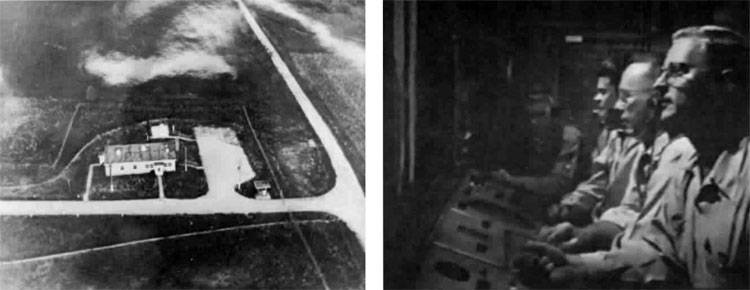
(Left) Historic aerial photograph of the entrance to the Launch Area of Nike Base SL-40. The sentry guardhouse is on the right; the ready building is at lett. BECK VOCATIONAL SCHOOL. (Right) Missile crew shown inside a control trailer. Note the crewman in the foreground monitoring the target-tracking test with a stopwatch, BELL LABORATORIES, THE NIKE-HERCUIES STORY.
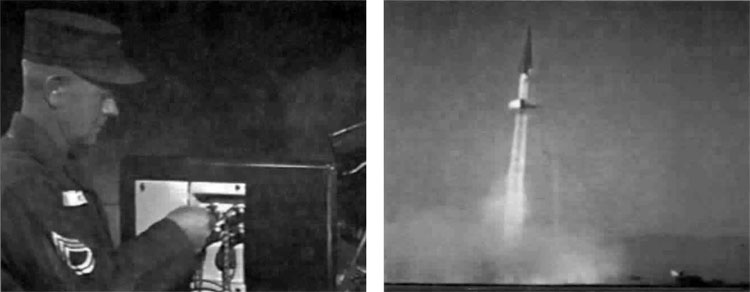
Images from Bell Laboratories' film The Nike-Hercules Story showing a missile crewman performing the final enabling sequence by inserting and fuming four individual keys in the system box (left) and a Nike missile during a lest flight (right).
The Nike system could fire one missile per minute for one hour against targets at moderate ranges (approximately 25,000 yards) and, if required, two missiles per minute for short periods against short-range targets (approximately 15,000 yards). Actual rates, however, varied according to prevailing circumstances.[111] Nike crewmen needed a minimum of 36 seconds to launch the first missile. This included approximately 30 seconds to acquire, identify, designate, and track a target; four seconds for computer settle; and two seconds for the fixed time interval between the initial fire order command and missile launch. A new missile could be launched approximately 11 seconds after the bursting or abandonment of the previous missile. After the previous target has been tracked, the acquisition radar operator was free to examine and interrogate any new targets.
There were two situations in which a missile'could be rejected. Either the missile-tracking radar failed to get an adequate signal response from the missile, or the missile did not fire within five seconds after the "fire" command signal. As soon as the red "reject" lamp lit, the elevator was lowered, and the rejected missile was removed; another missile was then loaded onto the elevator launcher.
Training and Inspection
The Army Air Defense Command instructed its commanders to: 1) Maintain 25 percent of all Nike batteries so that they were "capable of launching one effectively controlled missile within fifteen (15) minutes of receipt of signal or warning, and of maintaining sustained fire until the supply of ready missiles is exhausted;" 2) Ensure that 50 percent of all batteries were "capable of launching one effectively controlled missile within thirty (30) minutes of receipt of signal or warning, and of maintaining sustained fire until the supply of ready missiles is exhausted;" and 3) Allow 25 percent of all batteries to be on a training and maintenance cycle, retaining the "capability of returning to an operational status within two (2) hours of receipt of signal or warning."[112]
These alert-status measures had afar-reaching effect. As a result, Nike bases assumed a combat-like readiness, as 15-minute status permeated the atmosphere. A siren meant an exercise, a readiness test, or an attack; one
never knew. As Nike units had to meet these requirements 24 hours a day, they assumed an ever-increasing feeling of responsibility for the Nation's defense.
All personnel for Nike batteries trained at the Army Air Defense Center at Fort Bliss, Texas. At the center, Nike personnel studied each element of the Nike system. Commanders learned the overall operation of the missile system and their responsibilities. Radar personnel trained on radar equipment, and each battery underwent a series of tests. Nike personnel also participated in test firings of missiles at White Sands Missile Range, which occupied approximately 1,200 square miles of desert land in New Mexico. No Nike missile was ever fired from a U.S. installation, other than for training purposes at White Sands. The only exceptions were firings in Alaska to test the operation of Nike equipment under cold weather conditions. The Army also conducted live firing exercises in Okinawa, for Nike crews stationed in the Far East.
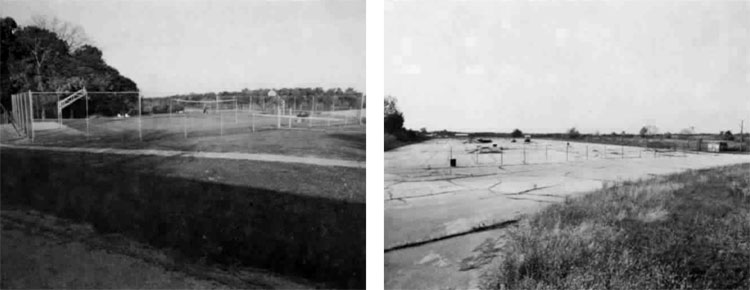
(Left) Most Nike bases had basketball courts to provide recreation for crew, who often reported that life at a Nike base could be boring between alert exercises. (Right) Launch Pads. Nike Missile Base SL-40. ARNOLD THALLHEIMER
Annual service practice, also called short notice annual practice, began July 1961 to enable batteries to fire a missile and to test their proficiency. As part of this practice, batteries traveled to Fort Bliss on only 48-hour notice. Once there, the units had one week to set up equipment, assemble, emplace, and fire their assigned missiles. Because batteries were selected at random, no one ever knew when they would he called and. therefore, could not "cram." Therefore, each battery had to maintain a high state of readiness. Competition for the annual high score was intense."[113]
When not participating in annual practice — or unless the battery was "hot," meaning that it was on duty 24 hours a day — Nike servicemen often reported that life at the missile installations could be tedious. Most Nike bases did have a basketball court to relieve excess energy. Sometimes, softball teams would play against teams in the community, or football teams would be set up within the Army to play one another."[114]
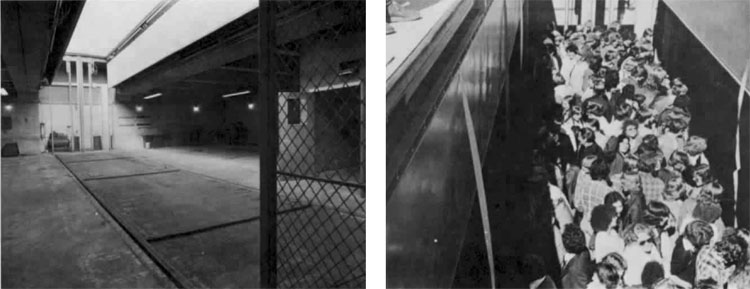
(Left) Interior of underground missile storage area (magazine). Nike Missile Base SL-40. Missiles were loaded onto the elevator floor, seen in the center of this photograph, and raised to the surface. As seen here, the elevator doors swung down to open. ARNOLD THALLHEIMER. (Right) In 1972. the Beck Vocational School moved into former Nike Missile Base SL-40. As part of the opening day ceremony, visitors were able to ride on the elevators of the underground missile storage areas, BECK VOCATIONAL SCHOOL
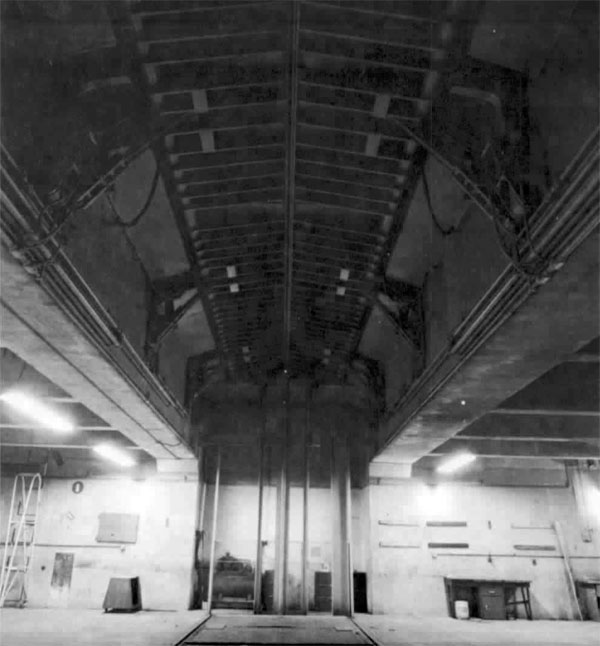
Opposite Page: Magazine interior with doors closed. Nike Missile Base SL-40. ARNOLD THALLHEIMER.
Inspections, planned or unplanned, broke up some of the monotony. From its inception, ARAACOM relied heavily on inspections to determine effectiveness of its unit. There were two types of inspections. The first was a formal command inspection of all assigned units conducted by the commanding general. The second consisted of an instruction visit by staff officers to units which required emphasis in some particular facet of training."[115]
Another type of inspection, which tested the firing unit was a "Blazing Skies" alert. These inspections could be either scheduled or surprise alerts, and sometimes occurred as often as once a week. As part of the alert, a randomly chosen aircraft entering the defense area was designated as an intruder, and all firing procedures, short of missile lainch, were performed. In addition, the Air Force Strategic Air Command and the Aerospace Defense Command periodically provided “faker” aircraft to simulate enemy aircraft for battery training. The Strategic Air Command combat crews benefited from these exercises, as they were also scored on target run and evasion techniques."[116]
DEACTIVATION
Nike Missile Base C-84 closed in 1963, one of the first deactivated in the Chicago-Gary Defense Area. As reported by the Chicago Tribune, the Nike Ajax base, which was manned by the National Guard, was closed because it not accommodate the larger Nike Hercules missiles. Several other Nike installations in the Chicago area — including bases in Naperville, Munster (Indiana) and at the Argonne National Laboratories — had also been manned by National Guard units. However, since these other bases converted to Nike Hercules missiles, they remained active until 1971.[117]
On June 10,1963, Lake County began leasing Nike Missile Base C-84 from the U.S. Army for the purposes of civil defense, records storage, and as an auxiliary highway department site. The Army declared the property government surplus in 1964. On November 26,1965, the Government Services Administration quit-claimed the 26.87 fee simple acres and the 0.18 acre access and utility easements to the County of Lake, Illinois. In 1969, Lake County sold the Battery Control Area portion of the base, comprising 11.07 acres.[118]
At the time of the Historic American Engineering Record of Nike Missile Base C-84, Lake County was offering the Launch Area for sale. The Battery Control Area has been razed. In recent years, proposed uses for the base have included an expansion of the County Youth Home, the location for the county jail's work release program, and a shooting range for the sheriffs police.[119] Indeed, several former Nike bases in the Chicago area have been converted to new uses. At Arlington Heights, Illinois, a Nike installation has been converted into a golf course; the missile magazines filled and planted over. In Orland Park, Illinois, a Nike base serves as a civil defense center.
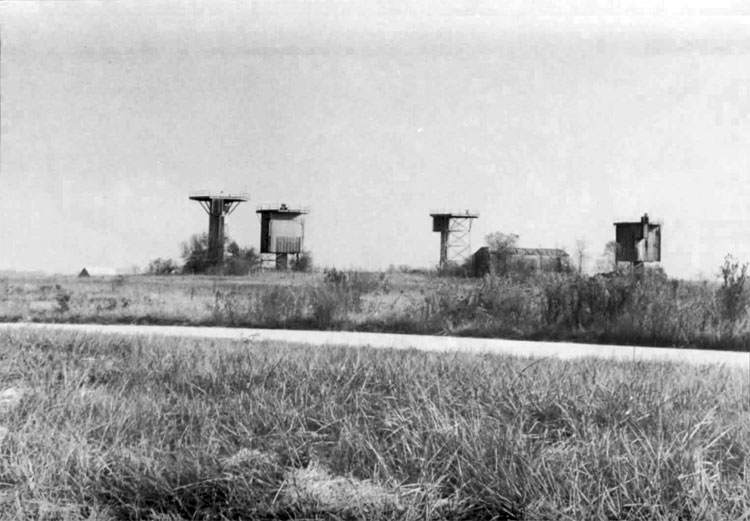
Nike missile bases are rapidly vanishing from the national landscape. Although some have been adaptively reused; most have been demolished or are in deteriorated condition. These towers once supported the acquisition and tracking radars of Nike Missile base SL-10 in Marine, Illinois, which was part of the St. Lous defense area. ILLINOIS HISTORIC PRESERVATION SOCIETY.
Other Nike bases around the country also have found new uses. The Parks and Recreation Department of Southfield, Michigan, incorporated a Nike base into a greenbelt park. The County of Lake, Ohio, uses Nike magazines for maintenance garages. In Wilmington, Ohio, a Nike site has been converted to a rehabilitation center. A private company in Wisconsin utilizes Nike magazines for explosive materials storage. The U.S. Bureau of Mines in Farmington, Minnesota, uses the magazines for mining research. In California, a former Nike base houses prisoners for the Department of Corrections. Nike Missile Base SF-88L at Fort Barry in Golden Gate National Park near San Francisco, California, has been partially restored and is open for guided tours on the first Sunday of every month.[120]
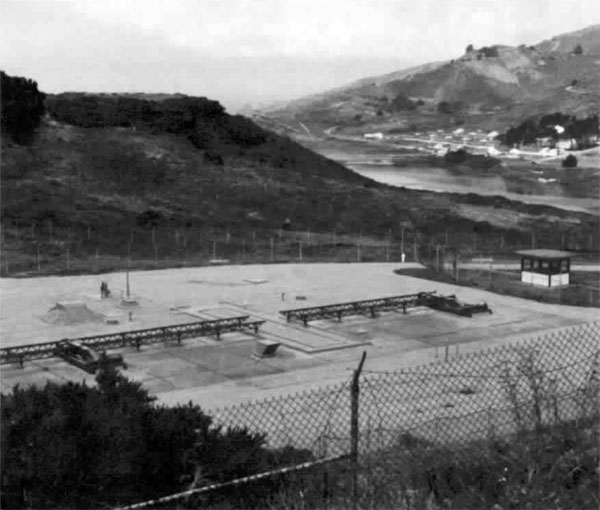
Nike Missile Site SF-88L, located in the Golden Gate National Recreation Area near San Francisco. The facility is open for guided tours on the first Sunday of every month. JAMIE DONOHUE.
Nike Missile Base SL-40 also has been converted to a non-military use. On August 16, 1968, the Army announced the deactivation of 23 Nike Hercules bases nationwide, including those in the St. Louis Defense Area. The Army declared Nike Missile Base SL-40 non-operational on October 1, 1968. The site was declared excess by the Department of Defense on June 9, 1969, and transferred to the Government Services Administration.[121] The Government Services Administration released the site to the Department of Health. Education and Welfare which, in turn, quitclaimed the site to the County Board of School Trustees of Monroe County, Illinois, on May 28, 1970. Monroe County utilizes the site as the Beck Vocational Center on behalf of the Waterloo Community Unit School District No. 5.[122]
The Beck Vocational Center opened on August 19, 1972. In 1974, the center remodeled all of the former Nike buildings, and constructed three new buildings on the campus. Charles Strautz, the site's original owner, was employed at the Beck Vocational Center, first as a carpenter during the transition from Nike base to vocational school, and later as the plant engineer and head custodian, a position he held until August 1975.
In 1974, the nation's last 48 Nike batteries were phased out, with the exception of four batteries of Nike Hercules in Florida and Alaska. These four batteries, which were strategically located to Cuba and the Soviet Union, remained open for training purposes. Overall, the total production of the Nike Hercules amounted to over 25,000 missiles, of which 2,650 were exported under the Foreign Military Sales Program and 1,764 under the Military Aid Program.[123] Japan phased out its last Nike Hercules in November 1992.[124]
Cities and Sites Protected by Nike Installations
Abilene, Texas
Albany, Georgia
Anchorage, Alaska
Austin, Texas
Baltimore, Maryland
Barksdale AFB, Louisiana
Boston, Massachusetts
Buffalo - Niagara Falls, New York
Chicago, Illinois
Cincinnati - Dayton, Ohio
Cleveland, Ohio
Dallas - Fort Worth, Texas
Detroit, Michigan
Ellsworth AFB, South Dakota
Fairbanks (Fort Wainwright), Alaska
Hanford Reservation (Department of Energy), Washington
Hartford, Connecticut
Kansas City, Missouri
Key West, Florida
Loring AFB, Maine
Los Angeles, California
Miami (Homestead AFB), Florida
Milwaukee, Wisconsin
Minneapolis-St Paul, Minnesota
Mountain Home AFB, Idaho
New Haven, Connecticut
New York, New York
Norfolk, Virginia
Oahu, Hawaii
Omaha - Lincoln, Nebraska
Philadelphia, Pennsylvania
Pittsburgh, Pennsylvania
Providence, Rhode Island
Robins AFB, Georgia
San Francisco, California
St Louis, Missouri
Seattle, Washington
Spokane, Washington
Walker AFB, New Mexico
Washington, DC.
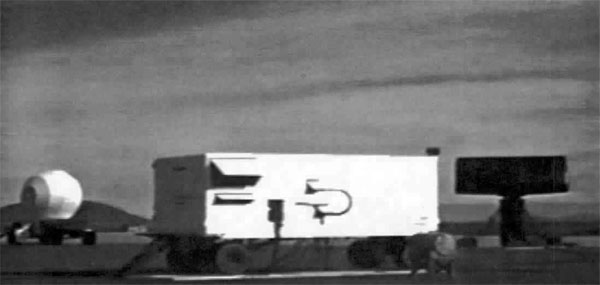
Left to Right – Mobile high-power radar (HIPAR), control trailer, and low-power (LOPAR) acquisition radar. BELL LABORATORIES, THE NIKE-HERCULES STORY
ENDNOTES
1. John Lewis Gaddis, the United States and the origins of the Cold War, 1941-1947 (New York: Columbia University press, 1972), 137.
2. Ibid., 139.
3. Ibid., 136.
4. Ibid., 163.
5. William O'Neill, American High: The Years of Confidence, 1945-1960 (New York: The Free Press, 1986), 66.
6. John Patrick Diggins, The Proud Decades: America in War and Peace, 1941-1960 (New York: W.W. Norton & Company, 1988), 82.
7. Ibid., 76.
8. Post-War Hopes, Cold War Fears. Executive Producer: Mert Koplin. Produced by Imre Horvath. Writers: Imre Horvath, Bill Moyers, Bernard Weinberger. Created and developed by The Corporation for Entertainment and Learning, Inc. and Bill Moyers. Washington, D.C.: PBS Video, 984.
9. Diggins, 80.
10. Greece and Turkey were added to NATO in 1952; West Germany was added in 1955.
11. Diggins, 81.
12. Ibid.
13. John Newhouse, War and Peace in the Nuclear Age (New York: Alfred A. Knopf, 1989), 110.
14. Lawrence S. Wittner, Cold War America — From Hiroshima to Watergate (New York: Praeger Publishers, Inc., 1974), 144-5.
15. Lieutenant Colonel Roy S. Barnard, The History ofARADCOM, Volume I, The Gun Era 1950-1955 (Headquarters ARADCOM, Historical Project ARAD 5M-I, n.d.), 3.
16. BDM Corporation, Vienna, VA. "Draft: History of Strategic Air and Ballistic Missile Defense, 1945-1955" (For the Department of the Army, Chief of Military History, Washington, D.C., March 15,1975), Volume I, Section A, 12.
17. Barnard, 3.
18. Ibid., 5.
19. BDM Corporation, Volume I, Section A, 14.
20. Barnard, 8.
21. BDM Corporation, Volume I, Section A, 14.
22. Barnard, 9.
23. Jacob Neufeld, Ballistic Missiles in the United States Air Force, 1945-1960 (Washington D.C.: Office of Air History, 1990), 239.
24. Ibid., 52; and Barnard, 27.
25. Neufeld, 53.
26. Merle T. Cole, "W-25: The Davidson Site and Maryland Air Defense," Maryland Historical Magazine, Volume 80, No. 3 (Fall 1985), 241.
27. Neufeld, 91.
28. Cindy Sage, A. Schilz, M. McDonald, "Mt. Gleason Nike Missile Site LA-04," HAER No. CA-57, (April 1988), 7.
29. Ernest J. Yanarella, The Missile Defense Controversy — Strategy; Technology; and Politics, 1955-1972 (Lexington: The University Press of Kentucky, 1977), 19.
30. Ibid.
31. Thomas R. Ross, "Air Force Seeks to Abolish Chicago Nike Installations," Chicago Sun Times, 1 September 1958.
32. Ibid.
33. "Poor Rating for Hercules," The Milwaukee Journal, 27 May 1959, Center of Military History, Washington D.C.
34. M.D. Fagen, ed., A History of Engineering and Science in the Bell System — National Service in War and Peace (1925-1975) (Bell Telephone Laboratories, Inc., 1978), 360.
35. Barnard, 15.
36. Fagen, 370.
37. Ibid., 371.
38. Mary T. Cagle, Historical Monograph: Development, Production, and Deployment of the Nike Ajax Missile System, 1945-1959 (Redstone Arsenal, Alabama: U.S. Army Ordnance Missile Command, 30 June 1959).
39. Ibid, 133.
40. BDM Corporation, Volume I, Section B, 29.
41. Cagle, 181.
42. Bill Gunston, The Illustrated Encyclopedia of the World's Rockets and Missiles (London: Salamander Books, 1979).
43. Ibid., and Environmental Science and Engineering, Inc., Gainesville, Florida, Historical Overview of the Nike Missile System (Aberdeen Proving Ground, MD: U.S. Army Toxic and Hazardous Materials Agency, December 1984).
44. The Antiaircraft Artillery and Guided Missile School, Introduction to Nike I System (ST 44-161-1) (Fort Bliss, Texas: U.S. Army, April 1956), 66-67.
45. Environmental Science and Engineering, Inc., 5-5.
46. Fagen, 462.
47. Cagle, 1980.
48. Nike-Ajax, Now 'Senile' Missile, Institutionalized," The Pentagram News, 12 November 1964, Center of Military History, D.C.
49. Gunston.
50. Ibid.
51. Fage, 388
52. United:States Army Missile and Munitions Center and School, Nike Missile System Orientation (Redstone Arsenal, Alabama: United States Army Missile and Munitions Center and School, Rev. February 1976), 4.
53. Cole, 255.
54. Gunston; and United States Army Missile and Munitions Center and School, 4.
55. Gunston.
56. Ibid.
57. Yanarella, 60,99.
58. Fagen, 395.
59. James M. Gavin, Maj. Gen., 'Memorandum: Nike Deployment and Site Availability Plan," 21 April 1954, Office of History, Corps of Engineers, Fort Belvoir, VA, File 8/33/3.

A Nike Ajax missile rests on its launcher-loader assembly. REDSTONE ARSENAL.
61. Ibid., 182-3.
62. "One on the Lake Front Won't Take Extra Land," Chicago Daily News, 6 March 1956, Chicago Historical Society, Chicago, IL.
63. Department of the Army, U.S. Army Air Defense Employment (FM 44-1) (Headquarters, July 1962), 105-9.
64. Cagle, 188.
65. Ibid., 190.
66. Ibid.. 190, 193.
67. Ibid., 191.
68. Ibid., 193.
69. Chicago Sun Times, 20 November 1955, Chicago Historical Society, Chicago, IL.
70. "Army's Nike Guided Missile to be Installed in Nation's Anti-Aircraft Defense System," Department of Defense, Office of Public Information, Washigton, D.C., No. 1185-53,17 December 1953, Center of Military History, Washington, D.C.
71. Gavin.
72. Memorandum: Report of Nike Sites Advertised," 12 April 1954, Office of History, Corps of Engineers, Fort Belvoir, VA; ENGMN 4666; Memorandum, 22 April 1954, Office of History, Corps of Engineers, Fort Belvoir, VA; "Memorandum: Proposed Nike Deployment and Site Availability Plan,” 6 April 1955, Office of History, Corps of Engineers, Fort Belvoir, VA; and CONUS NIKE Program, "Memorandum: Proposed Nike Deployment," 3 December 1955, Office of History, Corps of Engineers, Fort Belvoir, VA.
73. United States Army Corps of Engineers, Chicago District. "Defense Environmental Restoration Program Inventory Project Report," Project No. E05IL007700 (n.d.), U.S. Army Corps of Engineers Office, Chicago District, Chicago, IL.
74. Oliver P. Prost, Comptroller, U.S. Army Engineer District, Chicago, "Memorandum: To ENGMC-CO," 5 June 1962, Office of History, Corps j of Engineers, Fort Belvoir, VA.
75. James A. Sawicki, Antiaircraft Artillery Battalions of the US Army, Volume I (Dumfries, VA: Wyvern Publications, 1991); and Directory and Station List of the U.S. Army, Center of Military History, Washington, D.C.
76. In the October 15,1959, Station List, a Palatine site (no site number given) is listed as Battery C for the 3rd Artillery, 6th Missile Battalion, Nike-Hercules. Nike Site C-84 was sometimes referred to as being in Palatine, a neighboring community. (It was also referred to as the Lake Zurich site). However, simultaneously, Site C-84 is included as Battery D for the 60th Artillery, 2nd Missile Battalion, Nike-Ajax. Given the information available regarding the use of C-84 solely as a Nike-Ajax Battery, the placement of the "Palatine" site, Nike Site C-84, under a Nike-Hercules Battalion appears to be an error.
77. R.E. Vollendorff, Colonel, GS Office, Chief of Legislative Liaison, to Honorable Marguerite Stitt Church, U.S. House of Representatives, December 28,1961, Office of History, Ft. Belvoir, VA.
78. Annual Report of the Chief National Guard Bureau (Washington, D.C.: Center of Military History, 1957).
79. Annual Report of the Chief National Guard Bureau (Washington, D.C.: Center of Military History, 1961).
80. "Army Plans No Nike Defense for St. Louis," Globe-Democrat, 4 February 1956, Mercantile Library, St. Louis, MO.
81. "Karsten Requests St. Louis Priority for Nike Missiles," unidentified newspaper, 11 March 1956, Mercantile Library, St. Louis, MO.
82. Army to Consider Sending Nikes Here," unidentified newspaper, 25 March 1956, Mercantile Library, St. Louis, MO.
83. "Nike to Protect St. Louis by 1958, General Promises," Globe-Democrat, 25 May 1956, Mercantile Library, St. Louis, MO.
84. Janice E. McKenny, Army Lineage Series, Air Defense Artillery (Center of Military History, United States Army, Washington, D.C., 1985); 'Troops to Man Nike Sites Here Around Sept. 15," 26 August 1959, unidentified newspaper, Mercantile Library, St. Louis, MO.
85. "Defense Environmental Restoration Program Inventory Report."
86. Engineering News Record 161, No. 12 (18 September 1958): 85.
87. Cole, 251.
88. Introduction to Nike I System (ST44-161-1), 84.
89. The Antiaircraft Artillery and Guided Missile School, Underground Launching Equipment (ST44-161-31) (Ft. Bliss, TX: U.S. Army, November 1955).
90. The Antiaircraft Artillery and Guided Missile School, Battery Control Circuits and AC Transmission Circuits (ST-44-161-3G) (Ft. Bliss, TX: U.S. Army, November 1955).
91. Ibid.
92. Introduction to Nike I System (ST 44-161-1).
93. Cagle, 187.
94. United States Army Missile and Munitions Center and School.
95. Introduction to Nike I System (ST44-161-1), 88.
96. Battery Control Circuits and AG Transmission Circuits (ST 44-161-3G), 6.
97. Ibid.
98. The Antiaircraft Artillery and Guided Missile School, Underground Launching Equipment (ST44-161-31) (Fort Bliss, Texas: October 1955), 3.
99. Department of the Army, Nike I Systems: Nike IRound Launching Area and Assembly Area Equipment (TM9-5000^1) (Army Headquarters: April 1956), 27.
100. Ibid.
101. Ibid.
102. Ibid.
103. Sage et al., 30.
104. Battery Control Circuits and AG Transmission Circuits (ST44-161-3G), 6.
105. Cole, 242.
106. Brochure issued for 29 January 1958 presentation to Lieutenant Colonel Adam J. Eisenhauer, by the 32nd Antiaircraft Artillery Brigade, my stationed in West Germany, in the files of the Center of Military History, Washington, D.C.
107. ibid., 11-24.
108. United States Army, The Nike-Hercules Story, produced by Herbert Kerkow, Inc., New York, NY, presented by Bell Telephone Co., n.d.
109. Cole, 251.
110. Introduction to Nike I System (ST 44-161-1), 57.
111. Battery Control Circuits and AG Transmission Circuits (ST 44-161-3 G), 8-9, 24. d,
112. Barnard, 184-5.
113. Cole, 254.
114. James W. Dunn, Historian, Fort Belvoir, VA, interviewed by Christina M. Carlson. Mr. Dunn was a 2nd Lieutenant at a Nike site in Los , CA.
115. Barnard, 171-2.
116. Cole, 254.
117. Chicago Tribune, 18 May 1973; and "Certain Mileposts Re: Nike Site New Lake Zurich (n.d.) photocopy, files of the Lake County Museum, Wauconda, IL.
118. Nike Missile Site C-84 files, Lake County Museum, Wauconda, IL; and "Defense Environmental Restoration Program Inventory Project Report”.
119. Lake Zurich ((IL) Daily Herald, 23 January 1992; and Pioneer Press, 21 November 1985, in the files of the Lake County Museum, Wauconda, IL.
120. Sage at al.. 1; and Richard J. Sommers, Department of the Army, Carlisle Barracks, Pennsylvania, to Christina Carlson, October 1992, transcript in the files of Christina Carlson, BREGMAN & COMPANY, Inc., Bethesda, MD.
121. United States Army Corps of Engineers, Chicago District, "Report of Excess Real Property" (Chicago, IL: United States Army Corps of Engineers, Chicago District, 9 June 1969).
122. “Defense Environmental Restoration Program Inventory Report."
123. Duncan S. Lennox, ed., Jane's Strategic Weapons Systems (Surrey, United Kingdom: Jane's Information Group, 1990); and Gunston.
124. Tim O’Gorman, Curator at U.S. Army Air Defense Artillery Museum, Fort Bliss, TX, interviewed by Christina M. Carlson.
BIBLIOGRAPHY
Books
Ambrose. Stephen E. Eisenhower: Volume Two, The President. New York: Simon and Schuster, 1984.
Diggns, John Patrick. The Proud Decades: America in War and Peace, 1941-1960. New York: W.W. Norton & Company, 1988.
Fagen, M.D. ed. A History of Engineering and Science in the Bell System — National Service in War and Peace (1925-1975). Bell Telephone Laboratories, Inc., 1978.
Ford, Brian. German Secret Weapons: Blueprint for Mars. New York: Ballantine Books, 1969.
Gaddis, Johh Lewis. The United States and the Origins of the Cold War, 1941-1947. New York: Columbia University Press, 1972.
Gunston, Bill. The Illustrated Encyclopedia of the World's Rockets and Missiles. London: Salamander Books, 1979.
Lennox, Duncan S., ed. Jane's Strategic Weapons System. Surrey, United Kingdom: Jane's Information Group, 1990.
Millett, Alan R, and Peter Maslowski. For the Common Defense, A Military History of the United States of America. New York: The Free Press, 1984.
Neufield, Jacob. Ballistic Missiles in the United States Air Force 1945-1960. Washington, D.C.: Office of Air Force History, 1990.
Newhouse, John. War and Peace in the Nuclear Age. New York: Alfred A. Knopf. 1989.
O’Neil, William. American High: The Years of Confidence, 1945-1960. New York: The Free Press, 1986.
Pocock, Rowland F. AMSE. German Guided Missiles of the Second World War. New York: ARCO Publishing Co., 1967.
Sawicki, James A. Antiaircraft Artillery Battalions of the US Army. Volume I. Dumfries, VA: Wyvern Publications, 1991.
Wittner, Lawrence S. Cold War America — From Hiroshima to Watergate. New York: Praeger Publishers, Inc., 1974.
Yanarella, Ernest J. The Missile Defense Controversy—Strategy, Technology, and Politics, 1955-1972. Lexington: The University Press of Kentucky, 1977.
Yarmolinsky, Adam. The Military Establishment—Its Impacts on America. New York: Twentieth Century Fund, Harper & Row, Publishers, Inc., 1971.
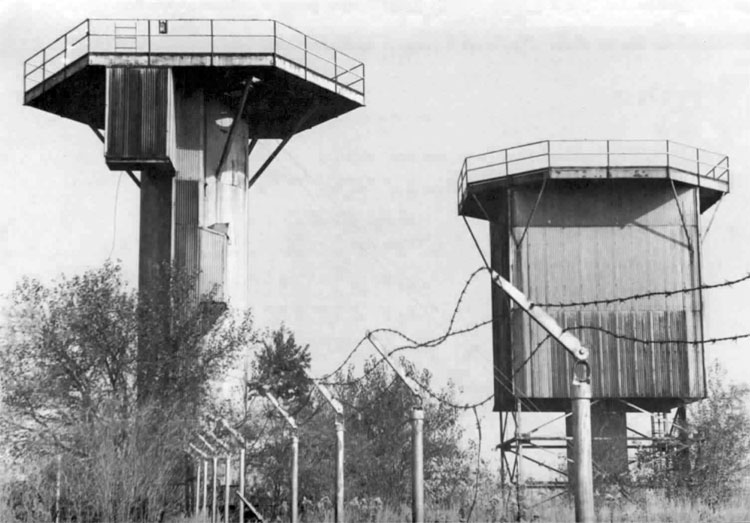
These radar support towers stand as silent sentinels to a by-gone era – Nike Missile Base SL-10 in Marine, Illinois. ILLINOIS HISTORIC PRESERVATION AGENCY
Military Monographs and Reports
32nd Antiaircraft Artillery Brigade, U.S. Army stationed in West Germany. Brochure issued for the presentation to Lieutenant Colonel Adam J. Eisenhauer, January 29, 1958. Center of Military History, Washington, D.C.
Annual Report, Report of the Chief National Guard Bureau. Washington, D.C.: Center of Military History, 1957.
Annual Report, Report of the Chief National Guard Bureau. Washington, D.C.: Center of Military History, 1961.
"Army's Nike Guided Missile to be Installed in Nation's Anti-Aircraft Defense System." No. 1185-53. Washington, D.C.: Department of Defense, Office of Public Information, December 17,1953. Center of Military History, Washington, D.C.
Barnard, Lieutenant Colonel Roy S. The History of ARADCOM, Volume I, The Gun Era 1950-1955. Headquarters ARADCOM, Historical Project ARAD 5M-I, n.d.
BDM Corporation, Vienna, VA. "Draft: History of Strategic Air and Ballistic Missile Defense, 1945-1955." Volumes I and II. For the Department of the Army, Chief of Military History, Washington, D.C., March 15,1975.
Cagle, Mary T. Historical Monograph: Development, Production, and Deployment of the Nike Ajax Guided Missile System, 1945-1959. Redstone Arsenal, Alabama: U.S. Army Ordnance Missile Command, June 30, 1959.
Cagle, Mary T. History of the Nike Hercules System. Chapters I & II. Redstone Arsenal, Alabama: U.S. Army Ordnance Missile Command, Historical Monograph Project Number: AMC 75M, April 19, 1973.
CONUS NIKE Program. "Memorandum: Proposed Nike Deployment, December 3, 1955." Office of History, Corps of Engineers, Fort Belvoir, Virginia.
Department of the Army. We Need BOMARC. n.d. The Center for Military History, Washington, D.C.
Directory and Station List of the U.S. Army. Center of Military History, Washington, D.C.
ENGMN 4666. "Memorandum, April 22, 1954." Office of History, Corps of Engineers, Fort Belvoir, Virginia.
Environmental Science and Engineering, Inc., Gainesville, Florida. Historical Overview of the Nike Missile System. Aberdeen Proving Ground, Maryland: U.S. Army Toxic and Hazardous Materials Agency, December 1984.
Gavin, James M., Gen. Maj. 'Memorandum: Nike Deployment and Site Availability Plan, April 21,1954." Office of History, Corps of Engineers, Fort Belvoir, Virginia, File 8/33/3.
“Memorandum: Proposed Nike Deployment and Site Availability Plan, April 6,1955." Office of History, Corps of Engineers, Fort Belvoir, Virginia.
“Memorandum: Report of Nike Sites Advertised, April 12, 1954." Office of History, Corps of Engineers, Fort Belvoir, Virginia,
Prost, Oliver P., Comptroller, U.S. Army Engineer District, Chicago. 'Memorandum: To ENGMC-CO, June 5, 1962." Office of History, Corps of Engineers, Fort Belvoir, Virginia.
United States Army Corps of Engineers. "Conversion From Ajax to Hercules." presentation, Trawicky, Chief, Missiles Branch, Engineering Division to Assistant Chief of Engineers for Military Construction, July 18, 1957, transcript at the Office of History, Corps of Engineers, Fort Belvoir, Virginia.
United States Army Corps of Engineers. "Primary Switches: Site C-84, Chicago-Gary Defense Area, Launching and Housing Area." Engineering drawing. March 12,1959.
United States Army Corps of Engineers, Chicago District. "Defense Environmental Restoration Program Inventory Project Report." Project No. E05IL007700. Chicago: United States Army Corps of Engineers Office, Chicago District, n.d.
United States Army Missile and Munitions Center and School. Nike Missile System Orientation. Redstone Arsenal, Alabama: United States Army Missile and Munitions Center and School, Revised February 1976.
Vollendorff, R.E., Colonel, GS Office, Chief of Legislative Liaison, to Honorable Marguerite Stitt Church, U.S. House of Representatives, December 28. 1961. Office of History, Fort Belvoir, Virginia.
Historic American Engineering Record (HAER) Reports
Sage, Cindy, A. Schilz, and M. McDonald. "Mt. Gleason Nike Missile Site LA-04." HAER No. CA-57. April 1988.
Military Manuals
The Antiaircraft Artillery and Guided Missile School. Battery Control Circuits and AG Transmission Circuits (ST 44-16 1-3 G). Fort Bliss, Texas: U.S. Army, November 1955.
The Antiaircraft Artillery and Guided Missile School. Introduction to Nike I System (ST 44-161-1). Fort Bliss, Texas: U.S. Army, April 1956.
The Antiaircraft Artillery and Guided Missile School. Underground Launching Equipment (ST 44-161-31). Fort Bliss, Texas: U.S. Army, October 1955.
Department of the Army, Headquarters. Field and Depot Maintenance Repair Parts and Special Tools List: Radar Course Directing Central Antenna-Receiver-Transmitter Group, Acquisition OA-I6OI /Tand OA-1596/T (Nike-Hercules Antiaircraft Guided Missile System) (TM9-1430- 250-35P/2). May 1960.
Department of the Army, Headquarters. Nike I Systems: Nike I Round Launching Area and Assembly Area Equipment (TM9-5000-4). April 1956.
Department of the Army, Headquarters. U.S. Army Air Defense Employment (FM 44-1). July 1962.
Technical Manual: Operator's, Organizational, Direct Support, and General Support Maintenance Repair Parts and Special Tools Lists (Including Depot Maintenance Repair Parts and Special Tools) Illustration Supplement for Radar Course Directing Central Antenna-Receiver-Transmitter Group, Target Tracking, Trailer Mounted AO-1487A/MPA (FSN1430-775-0266) and AN/MPA-55 (FSN1430-433-9144) (Improved Nike-Hercules Air Defense Guided Missile System) (TM9-1430-250-14P-7-2). July 1974.
Journals, Magazines and Newspapers
"Certain Mileposts Re Nike Site New Lake Zurich." n.d., photocopy, files of the Lake County Museum, Wauconda, Illinois.
Chicago Sun Times. November 20,1955.
Chicago Tribune. May 18, 1973.
Cole, Merle T. "W-25: The Davidson Site and Maryland Air Defense." Maryland Historical Magazine. Volume 80, No. 3, Fall 1985.
Lake Zurich Daily Herald. January 23,1992. Files of the Lake County Museum, Wauconda, Illinois.
"Nike-Ajax, Now 'Senile' Missile, Institutionalized." The Pentagram News, November 12,1964. Center for Military History, Washington, D.C.
"One on the Lake Front Won't Take Extra Land." Daily News, March 6,1956. Chicago Historical Society, Chicago, Illinois.
The Oregonian. September 23,1958.
Pioneer Press. November 21,1985. Files of the Lake County Museum, Wauconda, Illinois.
"Poor Rating for Hercules." The Milwaukee Journal. May 27,1959.
Ross, Thomas R. "Air Force Seeks to Abolish Chicago Nike Installations." Chicago Sun Times, September 1, 1958.
